#his action background was really obvious as was his lack of experience in other areas in this one
Text
I watched Barbie and Oppenheimer and they were just...okay. :/ I think I already talked about Barbie a bit. Tl;dr: it was aesthetically pleasing, but pacing and writing were horrific, Barbie's arc was all over the place and expected, and it was really dated and tried to do like three different things that didn't end up doing any of those three things well).
With regard to Oppenheimer, I didn't hate it, but I feel like it, more than any of his movies I've seen (and enjoyed or was neutral about), highlighted Christopher Nolan's limitations and inexperience with certain things.
It felt like it was two movies squeezed into one unsuccessfully, and I'd rather it have picked one. I actually think it might've been better as a limited series, but they would have never made one for lots of reasons. The pacing and editing were odd, distracting, and confusing and same goes for some cinematographic choices; the narrative choices were sooooo rudimentary to the point of being a bit childish (omg please...I wanted to take a red pen and start slashing away at the script and writing notes); and I don't know if it was just my theater, but the sound was awful. This isn't unique to Oppenheimer as we've all been aware of for several years now, but I was straining to hear a lot of the dialogue and when there was loud music, it was virtually inaudible.
The star-studded cast prevented me from immersing myself in the movie too because it screamed "BIG STUDIO MOVIE BY BIG DIRECTOR ABOUT BIG PROJECT EVERYONE IS DYING TO BE IN!" It became a game of "who's who" for me at some point. We could've gotten away with casting newbies, guys, especially for the bit roles.
And some of the actors didn't impress me; Florence and Robert were okay which is disappointing because I'm very fond of them. I'm not sure why everyone was raving that this is a RDJ Oscar nom; tbh, I thought he slipped into his usual mannerisms and RDJ-ness in the second half/last third of the movie. Still good of course because he knows how to act, but it felt like he was treading familiar territory for me despite the very different character he's playing. But he's also such a unique actor and person that it's hard to ignore all the things that make him him; it can be hard for me to forget he's RDJ. :/ Still excited that he's taking on projects like this and The Sympathizer!
But I guess...the reason why I didn't hate it was because I at least like the fact that Nolan's trying something new and I'm giving him some grace because of that? And there are still things he does that I like and the talent is there. AND OF COURSE Cillian. He made the movie. I understand wanting to put your blorbo in everything you do (this is like Bong Joonho and Song Kangho for me lakdfjsa), and what a great blorbo to have. He was SO SO SO good and I forgot how much I love watching him act and how much I missed seeing him. Everything he did was *chef's kiss *mwah.
#me watching the movie: *gnawing my arm off because cillian is killing it*#but fr why did we need hughie the boys rami malek josh peck dane dehaan etc. those roles could've gone to anyone#and okay i was prepared to see a sex scene but i was still unprepared lmdslfajfdia. NOLAN? SEX?#his action background was really obvious as was his lack of experience in other areas in this one#i think the reason it didn't jump out as much in his other movies as much as it did in this is because#most of his other movies if not all are still comfortably within the same realm even if they're different worlds and stories you know?#anyway. what's going to be my fall/winter movie? @ david fincher and hayao miyazaki don't let me down pls#i want good movies i can eat...i think the only one that i watched this year that i loved was across the spider-verse#still haven't watched past lives so maybe it'll hit the spot for me but i have some reservations about the premise so idk
1 note
·
View note
Text
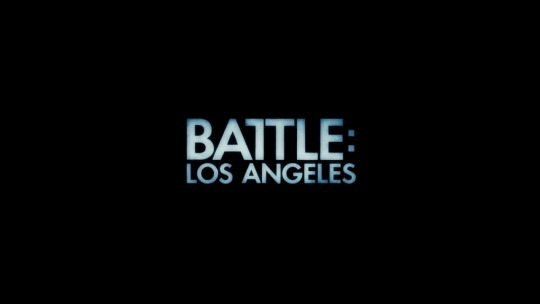

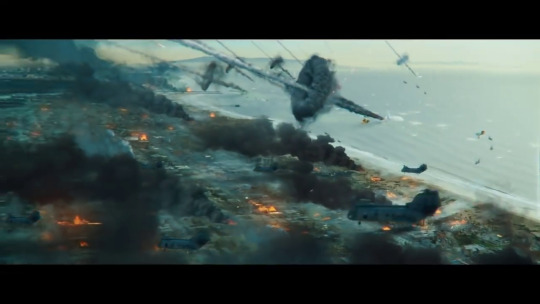
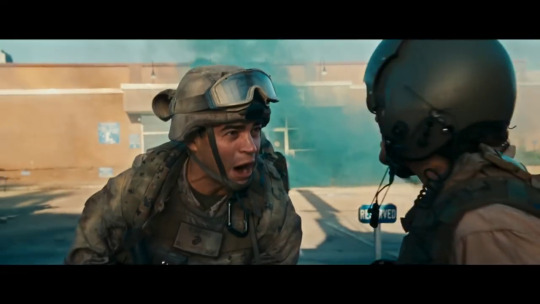
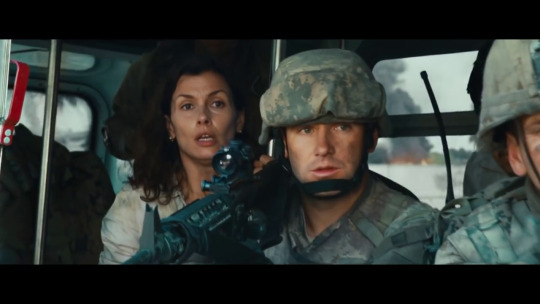

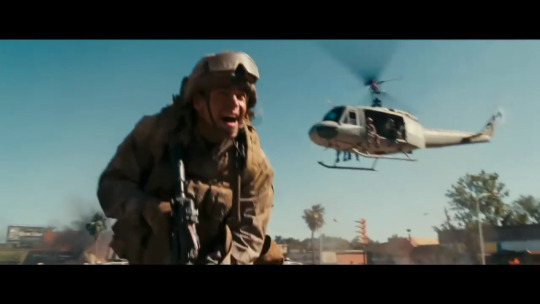


Battle: Los Angeles (2011)
Film review #610
Director: Jonathan Liebesman
SYNOPSIS: Strange meteors begin falling from space and landing in the ocean around major coastal cities. It turns out that are not meteors at all, but aliens intent on the invasion of Earth. A marine unit is assigned to the evacuation of civilians, and finds itself heading onto the frontlines in an attempt to bring some civilians home before the area is bombed...
THOUGHTS/ANALYSIS: Battle: Los Angeles is a 2011 sci-fi military alien invasion film. Starring Aaron Eckhart as Staff Sargent Michael Nantz, he is forced into a unit before his retirement to help evacuate civilians in Los Angeles, as it turns out a meteor shower that has dropped meteors off the shore of coastal cities around the world is actually the start of an alien invasion. Focusing on Nantz and the military platoon he is assigned to, the film feels like Black Hawk Down with an alien invasion plot, with the aim of creating that sense of the viewer being on the ground amidst the thick of the action. It does this with the low camera angles and close ups that put you on the same level and right beside the characters, to generate that kind of adrenaline and urgency that the situation demands. At first, it definitely feels disorienting as the camera shakes about and you can't get an establishing shot to position yourself, but you do get somewhat used to it. Also, the film does seem to pull back from this technique in the bigger action scenes to use more typical shots and compositions, whether that's because of the bigger scale of the aliens, or the lack of expertise to pull off the more advanced scenes is difficult to say. Regardless, the overall story is very much a typical alien invasion story in the typical Los Angeles setting, which hampers the film's ability to offer too many surprises.
At the beginning of the film, we are briefly introduced to the marines that make up the squad, their families etc., but it's all done very quickly, and we don't get much of a sense of distinguishing many of the characters. However, it's not too important to know their backstories when they're in the heat of combat, it's just that it would be nice to be able to distinguish them a little to stop those scenes becoming very cluttered. Aaron Eckhart is a commanding and likable lead, with the typical baggage his character as a combat veteran has. The rest of the characters, as mentioned, are briefly introduced at the start, or throughout, so we have a basic idea of who they are, but their backgrounds don't matter too much once you get into the combat. The film also keeps you guessing which characters are going to make it, although the death's of some of them are fairly obvious. The aliens themselves we don't see too much of, but they are weird and 'alien' enough to offer something a little different. Their background and motivations aren't explored too much, but again, that's part of the film being from the soldier's perspectives, where you don't need to worry about anything other than killing your enemy.
We get the usual big scenes of destruction that you would expect, but there's nothing much to distinguish it from all the over alien invasion films that are set in an American city. The film was actually shot in Louisiana with sets of Los Angeles reconstructed on location, so we obviously don't see too much of the city or it's landmarks. Overall, Battle: Los Angeles is a fairly entertaining one-time watch, but doesn't really distinguish itself from other alien invasion films set in a major U.S. city. The perspective from the military unit is jarring at first, but soon finds its rhythm. It's got enough to make it a complete experience, but there's not really much that will stay with you.
0 notes
Text
Tifa’s Fighting Style
One of the things that impressed me most about FF7R is Tifa Lockhart’s combat. Her mechanics were dazzling. Her combos left me awed. Her style was so realistic, but... what was it? Naturally, I did some digging, and happened to stumble across a blog where most of the work had already been done. So this post is courtesy of Flowerslightning, with thoughts and elaboration on my part. THANKS AND CREDIT TO THIS WONDERFULLY INSIGHTFUL BLOGGER (do check out her tumblr for more fantastic content).
First, let’s note that Tifa’s combat design is very much in the field of fighting games. To some degree at least, developers take inspiration from real-life arts. The style of Tekken’s Lei Wulong, for instance, is based on the Drunken First. Street Fighter’s Chun Li uses the model of Chinese Kenpo.
The FFVII devs - to my knowledge - have revealed nothing on Tifa’s inspired martial arts background. She adopted the monk style (the fisticuffs of FF-verse) from a traveler named Zangan. That’s all we know. She trained (obviously very hard) as his pupil for the 2 years between Cloud leaving Nibelheim and Sephiroth burning the town. Zangan then brought her to Midgar and continued his travels. The only path for discerning real-arts inspiration is through observing Tifa’s fights - though even such attempt is limited. Her style is not as straightforward as Lei’s or Chun Li’s. She seems to employ a mix of martial arts, specializing in the offense and using speed and dexterity to her advantage.
Here are the main styles that Flowerslightning deduced, supported by some of Tifa’s abilities.
1. Muay Thai [demonstrated by Somersault].
This is the known as the “Art of Eight Limbs” and is commonly referred to as “Thai boxing”. It differs from traditional kickboxing (which has its roots in Japan) most notably in being an 8-point instead of 4-point striking system. In other words, Muay Thai employs elbow and shin strikes in addition to kicks and punches. Tifa’s kicks, I would say, are actually more akin to kickboxing, for Muay Thai places emphasis on heavy kicks involving the shin bone. Yet her acrobatic style is very akin to the latter.
In addition to the key boxing techniques of both the Thai and Japanese art, Tifa’s elbow maneuvers provide further evidence for the former. This is most evident during her fight with Loz, where she uses her elbows for offense and defense. One could say she expanded her Thai-based skills during in the 2 years that followed saving the world.
Running a new bar and raising two under-10-year-olds would have left at least a... smidgen of free time, right?
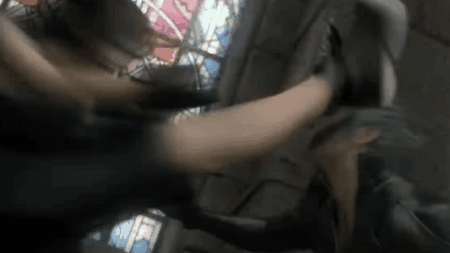
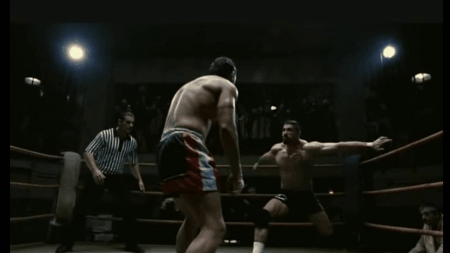
2. Muay Thai [demonstrated by Refocus].
Some may suggest this move of Tifa’s is a Taekwondo technique (we’ll get to that lovable sport soon, don’t you worry), but I agree with Flowerslightning in that her jumping style is more Muay Thai. Almost all Muay Thai techniques use movement of the entire body, rotating the hip with each kick, punch, elbow and block. This to me is the obvious discerning factor. Tifa exquisitely throws her whole body into the majority of her combos and limit breaks, ground and aerial alike. Specifically through that neat hip rotation. Refocus is but one example of many.
PS. Don’t you just love her boots? The gloves are really something but, those red boots... Just look at them.
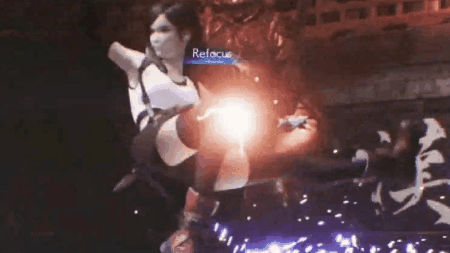

3. Taekwondo [shown in Overpower].
Literally the “Way of the Hand and Foot”, this is a Korean martial art set apart by its emphasis on kicks. Head-height kicks, jump spin kicks, swift kicks, the list goes on. (But of course, there’s plenty of hand blocking and take-downs too.) Did you know that Taekwondo is part of South Korea’s military training program as well as their national sport? Its skillset is heavy in self-defense.
Tifa is mostly an offensive attacker (and wow, do her strikes deal devastating damage). Yet her aerial maneuvers and acrobatic footwork certainly have elements of Taekwondo. What makes the Taekwondo kick-style unique is its elaborate, advanced forms. Xtreme 720s, for instance, are underpinned by precise technical soundness and accuracy.
Yes, these are literal 720° mid-air turns with a SERIES of kicks timed in utmost precision. They require extraordinary strength. Something Tifa deceptively pulls off with ease, no?

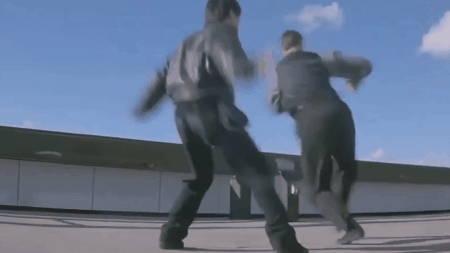
4. Hēi-Hǔ-Quán [displayed in Starshower].
Flowerslightning deduces this ATB ability to be a Boxing combo. Though to me it looks more like Hēi-Hǔ-Quán (lit. ‘Black Tiger Fist’, a Shaolin striking art from China). Watch her hands closely: the thumbs are curled like the fingers rather than wrapped around them to form a fist. Tifa’s wide stances and acrostic kicks are a little less tiger-esque than Hēi-Hǔ-Quán, but there is definitely resemblance of the style there too.
All in all, she seems to employ a mixture of Shaolin arts and Boxing. Her finger-positions for fast jabs (as in Starshower and the Loz fight) are predominantly of the Tiger Fist. Her more powerful strikes, meanwhile, include Boxing crosses, hooks and uppercuts. The sewer cutscene demonstrates this clearly, when Tifa & Cloud encounter the Sahagin.
And damn, do we love the back-to-back Cloti in that scene. Surely I’m not just speaking for myself here.
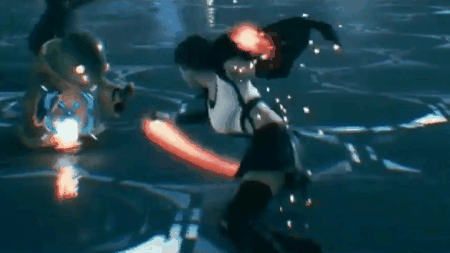

5. Boxing [displayed in Unbridled Strength].
Tifa’s aforementioned fist moves and powerful finishing punches are no doubt reminiscent of boxing. Also, she always enters a fight with her fists closed in a boxing stance (whether she will employ Shaolin or other hand techniques is irrelevant). Take her cutscene against the Whispers where she, Cloud and Aerith arrive at Sector 7. She begins with a cross and follows with a rotated hook - one of the most basic boxing combos.
BONUS FACT: Rather than orthodox, Tifa always employs a southpaw stance (right hand and right foot forward). This is the preferred stance of a left-hand fighter. Is Tifa left-handed? Considering her fighting alone, yes is the plausible assumption. Here are a few examples:
- Unbridled Strength has her delivering a finishing blow with her left hand. We would expect such a move to be done with the power hand.
- Her single strike that hurls Loz across the church is also with the left hand. This punch is not part of a combo; she could have used either hand.
- In guard position, her left is the rear hand, to both attack and protect herself.
- And of course, in southpaw stance, she always begins with a left-hand strike.
However, all of Tifa’s general actions (to my observance) - like bartending, catching Aerith in the sewer, carrying the Buster Sword into Corneo’s quarters, etc. - suggest that she is right-handed. So why use the left, the weaker, as her dominant hand in fighting? Could she actually be ambidextrous? That is a possibility. But weighing up the evidence in addition to Tifa's ingenuity, this could well be out of fighting strategy.
Southpaw can give Tifa a strategic advantage, you see, because of the tactical and cognitive difficulties her enemies would have of coping with a fighter who moves in a mirror-reverse of the norm. In other words, she takes advantage of the fact that most fighters lack experience against lefties. Doing this:
- opens up chance for a variety of surprise combos;
- puts her human enemies in danger of KOs by what would otherwise be ordinary strikes; and
- enables her to trick her opponents should she unexpectedly convert to orthodox during fights.
Pretty damn awesome, huh?
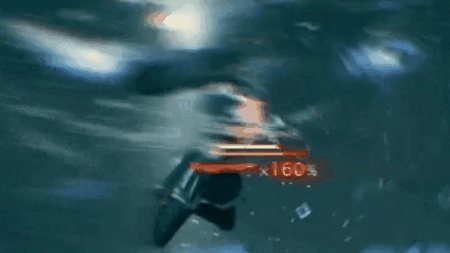
6. Gymnastics [dodging maneuvers].
Gymnastics, like fighting arts, enhances balance, strength, flexibility and agility - the four areas Tifa excels at. Now, we’ve talked a lot about her strong points. But what of her weaknesses? Players will have noticed immediately that Tifa has a major setback. She can accurately be described as a glass cannon, due to her low HP and defenses that counter-balance her speed and dexterity. That is precisely what makes playing as her so compelling; you get that sense of life or death intensity. The fight feels REAL. She is the least OP character in the party, in addition to by far being the most difficult to master. Utilized properly, she can be the strongest of them all. And wow, is that rewarding or what?
Because of her weak defenses, Tifa must constantly remain on the move, and gymnastics is the quintessential means in doing so. Hand springs, aerial cartwheels - you name it, she’s got it. As if those kicks and uppercuts don’t scream epic enough already. Doesn’t it just make her even MORE amazing?
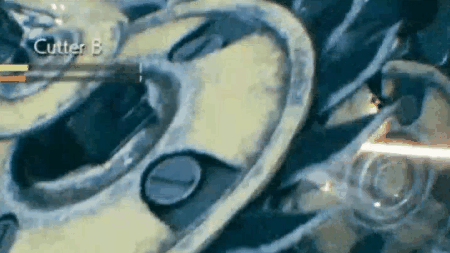
So I’ve added Hēi-Hǔ-Quán to Flowerslightning’s conclusion: that Tifa’s combat is Mixed Martial Arts, with her dominant skills as Kickboxing, Taekwondo and Muay Thai. And of course, the interweaving of Gymnastics, which adds an elegance to her epic kickassery.
Tifa lost her teacher after just two years, and spent the last five managing & running a bar, serving as AVALANCHE’s funder & treasurer, and effectively solo-raising Barret’s little daughter. Add two more years, and we have a completely absent Barret, a very sick child in addition to the one she is (now permanently) raising, and a depressed, distant Cloud who has left her to struggle as a solo barkeep, full-time nurse and single mother. How on earth did she find the time and will to master her fighting techniques?
Yes, we are talking about fiction, but this woman is nothing short of incredible. Not simply as a fighter - that isn’t even the start of it. Tifa is, to me, the character who has had it the hardest. Yet she perseveres. And not only that, but she gives. She gives and gives, and doesn’t give up, even when everyone else around her has. In addition, she is the only ‘ordinary’ member of the party: Cloud, on top of military training, had his senses enhanced with Mako & Jenova cells; Barret literally has a gun for an arm; and Aerith as the last Cetra possesses exceedingly strong magic. Tifa, like with everything she does, worked hard to hone her skills. And that, to me, is incontestably admirable.
As Flowerslightning put it, she was “ready to go through hell and yet still remain soft”. And those virtues she held to, where most people would have quit. Compassion and perseverance to the end, the two traits that uphold her - to me - as the most inspiring hero of fiction.
134 notes
·
View notes
Text
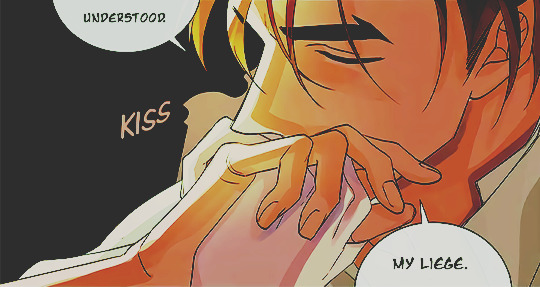
Viktor on every Harbingers.
As stated before, Viktor’s loyalty tend to be more to the people of Snezhnaya and the Harbingers than the Tsaritsa, who he sees more as a faceless tradition despite, yes, believing in the cryo archon’s mission. However, when it comes to his daily life, it is actually the Harbingers who possess his devotion.
Viktor is implied to have, at the very least, witnessed the harbingers which I imagine are during Fatui events, speeches and such, and is knowledgeable of both their way of work, their abilities, the personality they present, quirks and what the other Fatui think of them in general. This is a post based on the information we got so far in canon, the Commedia dell’arte and of course liberal interpretations to flesh out Viktor’s relation towards the harbingers, it is HEAVILY subject to change.
This list goes from who Viktor would like to work for the LEAST to the MOST.
Viktor admires all Harbingers and see how incredible they are to the Fatui cause, but this is purely him speaking selfishly in terms of working under them.
SCARAMOUCHE
Scaramouche is implied by Viktor to be pretty much universally disliked by the Fatui, which is supported by his shown temper. Scaramouche is one to belittle and not respect underlings, even potentially harming them physically through electro, and lead them with fear. Scaramouche throws emotional, gratuitous tantrums.
This is something Viktor cannot respect when strictly speaking of ways to run the chain of commands. This is no way to be a leader, not when you do not have reasons to apply this kind of authority. Scaramouche’s devastating power, however, is no joke, and given that the Tsaritsa has had her own reason to choose him, there is no question that Viktor would answer the man’s call and orders, but would he enjoy his daily working life under such a self-centered man with no respect for the lives he is responsible for but his own ? Not really. He’d sooner ask for a transfer... which is, unfortunately, not really possible within the Fatui, as you are to believe that where you are stationed is where you should be.
PIERRO
Pierro’s crazed antics constantly have one question his state of mind, and his chaotic mockery and obvious bitterness are made for a sour association, where one can never really rest as the man is too unpredictable. Underlings unable to guess what his plans are, given he never tell anyone anything.
Pierro doesn’t care what happens when his subordinates are sent on assignments, not caring if they are casualties or not. As someone who values his life, even if he is loyal and swore an oath to the chain of command, Viktor much rather stay alive. The man is... devastating.
SANDRONE
Sandrone uses underhanded tricks and manipulates people to get what he wants, hiding behind a face of kindness to the people. Although Viktor is one to recognize the grey areas of politics, which is, politics is everywhere in any social interactions, Sandrone stands out because he is not influencing people’s judgements, he is a hypocrite who takes advantage of commoners when they meet their lowest points.
This, alongside his eerie puppets... is absolutely terrifying. Viktor cannot help but, unlike Scaramouche where he sees the immaturity and lack of professionalism of one man, feel genuine fear... and fascination. The things he could learn from this man, he cannot even start to comprehend.
PULCINELLA
Pulcinella is the harbinger in charge of the Fatui’s military and, alternatively, its recruits camp. Viktor would be more than happy to give his body for the nation if needed, even if the battlefield is not his ideal position.
Technically, all Fatui receives a form of military training. The difference with Pulcinella is mainly that the Skirmishers are constantly enhanced through the Fatui technology, modified as their body belongs to the nation. Viktor personally has no interest in being cut open and changed, as he spent a significant amount of time perfecting his form and knowing his own body. Not everyone has the mental fortitude to be more than happy to be pumped with drugged and have their brain reconstructed to be a better martial weapon.
PANTALONE
As the one gathering all funds related to Snezhnaya and the Fatui, working for Pantalone is about contributing to the wealth of the nation, an absolute vital part which, however, comes with a ruthless environment. Whereas politics and influence are more subjective, wealth is about cold, hard numbers in an unsure, competitive scene.
Although Viktor is the first one to tell that there is no bad way to gather money and actually admire the length the man goes for the nation’s mission, what is more of a desk job with very little flexibility (the way political debates and diplomatic exchanges do) is bound to bore him out, thinking like his wits could be used elsewhere.
TARTAGLIA
When there is need for intimidation, Tartaglia Childe is the one sent by her Lady Tsaritsa. When there is need for muscles on the field, Tartaglia Childe is also the one sent. Although Viktor’s hunting background would technically make his skills appropriate for the task, Viktor is still not one who actually enjoys applying, let’s say, physical matters, especially unconventional ones Tartaglia Childe is sent into : it is not a straightforward army VS army combat. It is something which require finesse... a dangerous game which doesn’t necessarily fit Viktor.
As for the young lord himself, although he is one of the most respectable harbinger, Tartaglia’s impulsiveness and free spirit is known to suddenly put operations into chaos, without him going through the proper channels. This, honestly sounds both thrilling, rewarding and amazing... which is not Viktor’s cup of tea. However, Tartaglia has been proven to be the harbinger who respects underlings the most as individuals, despite his casual attitude giving some rookies the false impression that he is a softie... it just makes getting a disciplinary action from him harder.
SIGNORA
La Signora is her majesty’s most direct representative in the manners of political and courtly presence. Although working for Signora is a door to open many opportunities to political events for one’s ascension in their career, Signora knows the game... and plays it dirty. Many threats are given under technically diplomatic moves, and as someone who hates losing time on something else than her goals, she has no olive branch to any subordinate, who are pawns for her to be at her service like a mighty mistress... but her ways are always so bloody efficient, the results speak for her manners. Always ahead of the whole court. A queen in any place she walks in.
Technically, Viktor cannot complain about his position, although he is very disgruntled about being that low in the food chain... and extremely neglected. Sigh. Even if he is one to not bother about a pause to his advancements, Viktor cannot get, at least, the satisfaction of doing something for his home... because he’s not doing anything and he’s denying the fact that he’s been forgotten.
DOTTORE
Dottore is the most cerebral and knowledgeable of the harbingers, with actual results and hard work to show. As someone in need of mental stimulation, Viktor cannot help but be mesmerized at the constant studying opportunity, under a man who knows exactly what he is doing, what he wants, and makes it clear.
The practical application of skills and sense of professionalism make Dottore both a harbinger Viktor personally admire greatly and would like to work under : with such talent which shouldn’t, for Viktor, be wasted for a single second, he is no scientist, but would gladly do anything to remotely be useful to him. Dottore is actually one of the three harginers where Viktor’s respect, for various reasons, actually cancel part of the fear he would normally get from a man doing such harsh experiments.
CAPITANO
The first time Viktor laid his eyes on Capitano, he’d never forget. For whatever reason the man was in his region, probably some undisclosed assignments, he had never seen a man breathing so much charisma by merely existing. Amidst the men who’d try to appear strong and tall, Capitano didn’t have to be the tallest or largest to be absolutely mesmerizing. A man who commanded authority by presence alone.
He needed to be like him. And this is when a young Viktor decided to join the Fatui, not telling a single word that a single man triggered it all. Viktor doesn’t see himself as someone with particular talent, drive or patience to change the world... but if he could be half the man his idol was, that would be enough... but did he want to be the man, or solely be by his side, even if it meant potentially never working under him ? ... both.
As a recruit, Viktor would always run to the pavilion up the Fatui base to see Capitano entering the premises whenever his arrival was announced, watching from afar, get information on what the man had been up to. The stories of the man’s conquests, exploring uncharted territories while keeping such a solemn expression, an inspiring leader who’d run his affairs with the most unforgiving grip, to the perfection, with every bit of professionalism and no break in his composure.
If Viktor was to work under this man, he wouldn’t care a single bit about the treatment on his person. If he can be the slightest bit not indirectly, but directly useful to such a man, he would gladly serve him with every bit of devotion he has. Travelling at his side with the most powerful assets to the Fatui, each challenge only one exciting puzzle after one another.
If Viktor sees the holy Tsaritsa as the Fatui’s queen, Capitano is his King.
#.otverzhennyy ( headcanon )#insert simp jokes here#this took me waaaay too long and it is SO confusing but I needed t oat least have something done for this
16 notes
·
View notes
Text
sharing a short dousy video edit i made.
i don't know why but i really like this and thought i'd share it on here too.
should i rant about what goes in my head while making this video? no. will i? yes.
basically the song is beginning middle end by leah nobel from to all the boys i've loved before part 3. this song is basically about two people falling in love from the early years of their lives. since lara jean and peter met when they were kids. but then started (fake) dating in high school and their adventure together started right then and there. anyway, watch the movies if you haven't already. this song fits lara jean and peter so well (i don't know if it was written specifically for them or not).
but daisy and sousa didnt meet when they were kids because of one obvious reason: when daisy was a kid, sousa's dead; and when sousa was a kid, daisy hadn't been born yet. they weren't supposed to meet. so their journey started off separately.
daisy's beginning in shield was rocky, to say the least. but she found a home there with coulson, fitzsimmons and may (i'll get to ward) in season 1. they bonded quite quickly, mainly daisy skye and coulson. i think it shifts when she got shot by ian quinn. everyone in the team, especially ward was terrified and angry at the situation. now. she had a relationship with miles early on in the season, which was broken off. but within the context of the song, her beginning was ward. he was her s.o. she was falling for him when she uncovered that he's hydra. add that trauma to the ones she already had prior to shield. no wonder she has trust issues.
her middle was her powers. even though the story started early in the series, it's still the middle. because she struggled with her powers throughout seasons 2 - 5. the middle would always be the bulk of it all. it's where everything happens. it's the crux of a character, of a person. it's where daisy became daisy. now, in the middle of her middle (pun very much intended), was lincoln. the first inhuman who helped her and understood her. i'm sure they've got their own problems and everything, but it doesn't change the fact that he was someone who knew what she's going through. none of her found family could help her the way he could. this is where i think it gets interesting. seasons 2 - 5, where i said was her middle, and basically the peak/climax of daisy as a character, she was falling for and fell for lincoln. it was known that daisy was still in love with lincoln in season 5. possibly around 2 years after he died. but then we found out that she had moved on from lincoln in the beginning of season 6.
season 6 and 7 is the end of her journey with the team. they're still a family. just a family who occassionally see each other. now in season 6, like i mentioned previously, it was acknowledged that daisy had moved on. the past will always be with her, no doubt. the trauma would stick. hopefully just bits and pieces. but it would still be there until she either had alzheimer's, dementia, any other retrograde amnesia injuries or diseases, or the day she died. she would never forget lincoln or ward, heck even miles. she won't forget her past. unless it was taken away from her. so, back to the topic at hand, she wanted her own fitz. she had grown from the woman she was in the beginning, she had grown from the woman and superhero that she was in the middle. she knows who she is now. with the people she worked with. and the people she calls her family. and also with anyone. daisy's ending was perfect (to me at least). she wasn't looking for love right then and there. she was burnt one too many times. but she wanted that kind of love and support. the love and support that fitz and simmons have for each other. something that daisy lacked all her life. she ended up with someone who gave her what she wanted. and what she needed.
with sousa, it's a little different. because we didn't get to see much of his background and family life. we didn't get to know what his life was like during the war and before the war. we begin to see him in the ssr. we all knew, literally everyone knew, even the characters knew that sousa's practically in love with peggy. except for maybe peggy herself. but i'm sure she had an inkling. she definitely had an inkling. but then things go on and he became chief of the west coast office and he was in los angeles while peggy was in new york. he moved on (or so we thought). he started dating violet and was ready to marry her. he told her he loved her. and he did. it's just that he was also in love with peggy. still. and violet saw that. it's as clear as day. and they broke it off.
we didn't get to see much of sousa's middle. mainly because ac wasn't renewed for a third season. which was such a waste because it ended with so many things left unanswered. but we know that between 1947 - 1955, peggy and sousa broke up. we have no idea why. we don't know if steve was back. nada. all we know is that they broke up. when did they break up? again. no idea. but we know that peggy means a lot to sousa. she's like (sorta; i don't like making comparisons but anyway) sousa's lincoln in a way (i'm not saying that they're the exact replica. daisy/lincoln and peggy/sousa are quite different. but they do have similarities. those pairings are the kind where they want to be together forever but knew that it wouldn't work; my interpretation). she didn't die, we know that. but she's sort of the one that got away. my guess is that it's because shield and the world was more important than each other. which wasn't dissimilar to daisy and lincoln's situation. so, yes. peggy's sousa's middle. she influenced him a lot. and he found himself amidst ssr and shield (just like daisy did).
sousa's end was again, perfect. he went to the future. got to see what the organisation he helped build came to be. he went on an adventure to explore space. which he would geek out over. instead of dying, he got to live. with the love of his (new) life. he may be a man out of time, but with daisy and their ragtag family, he is right where he belongs.
daisy and sousa began with "who the hell are you" and ended with "it's beautiful" (just putting this here because i love that fact).
so. they started pretty quickly, didn't they? 4 episodes in and sousa fell in love with daisy. 7 episodes in and daisy fell in love with sousa. though i doubt that they thought they're in love. but they're falling. or walking towards it. 7x03 was when they met. it's where it all began. in area 51 of all places (foreshadow much?). but what's even more interesting is that technically, they began twice. from daisy's perspective, they met in 6x13 (which plenty of people had pointed out; but @agents-of-fangirling was the most recent). even though they didn't actually meet because sousa was wearing that blue (seriously his colour really is blue) hazmat suit and daisy was disoriented (may dying and all that jazz). but from sousa's perspective, they met in 7x03. where they actually made eye contact and conversed. how many couples can say that the when of their first encounter was debatable?
now. their middle, in the video edit, i used the scene from 7x10. because i think that's a pretty good middle. they had their first first kiss. sousa had no idea that happened. yet, there he was, wanting to help. just like his time-loop self. he extended a hand and she accepted. she accepted help. do you know how much of a development that was??? because i think that it's a huge character development (i still haven't rewatched so don't take my word for it). i think that's a good depiction of their middle. oh yeah. before i forgot. they also had two first kisses. and again, i say, how many couples can say that they had two first kiss? figured i'd choose the scene in the middle of those first kisses (pun intended lmao).
sidenote: did y'all see the devastation in her eyes when sousa volunteered to stay in the 80s? or how her eyes went wide and she started to panic when he was injected in the time loops? sousa's a man of action. and when he says something, he means it. so, his constant concern over daisy and him wanting to help in any way he can, it's his love language.
and then we have their ending. the perfect end to an imperfect couple (because nobody's perfect *cue hannah montana*). daisy got sousa a typewriter. because he's from the 50s. since when did daisy buy gifts for her boyfriends/partners/lovers? and they watched e.t. together? that's normal couple things. even though they are far from normal. but they get to experience it all together. daisy didn't get to in the past. none that we know of anyway. and now she does. also, that smile when she talks about him. that fond smile that grazed her lips at the thought of him. i've never seen her smile like that before (none that i remember; and if she did, well then i'm so so happy for her). she looks happy. serene. and her saying "he's a dork" twice in the season just makes my heart burst with happiness for them.
sidenote: my headcannon is that "he's a dork" is code for "i love him too much to explain it in words."
i'd like to believe that even though it has ended, their story has just begun. they're going through their middle right now. and i hope that they won't end. in other words, their end was not an ending. it was a beginning of a new life.
as daisy said, "we're loving the journey together." keyword: journey. it's a long road up ahead. with countless of challenges and obstacles in the way. but in the end, all that matters is that they face it together.
that's it. thanks for coming to my ted talk (for those who actually read it all the way through, i love you).
#watch the video til the very end😉#dousy#i know nobody's gonna read this#but i needed to hash it out#😬😬#character analysis#sort of#relationship analysis#🥺👉👈#sorry for the long ass post#like seriously long#i set out to write a quick lil paragraph and ended up writing an essay
23 notes
·
View notes
Text
104 Words for 104 Days: Dynasty Part 1: Princess
AN: Takes place in Doof Dynasty time period. Artistic liberties have been taken, and by that I mean a LOT of artistic liberties have been taken. Also, I really wanted to write something with Isabella as the protagonist and this seemed like a good place to do it. Since this turned out much longer than I expected, I decided to just divide it into two parts.
Dynasty Part 2 Coming Soon!
“Sir! Our defenses have been compromised!” General Carl shouted, rushing into the royal palanquin and collapsing into a dead faint in front of Regent Monogram.
Princess Isabella moved her ink pot before Carl’s head could smash into it. Sensing that the calligraphy lesson was over, she carefully put the materials away while Monogram waved a jar of incense in Carl’s face.
“General, don’t faint until you’ve given us the necessary exposition first,” Monogram scolded. “And especially not in front of the Princess.”
Carl nodded weakly. “Of course, sir. My apologies, Princess.”
“Accepted,” Isabella said. “What’s this about our defenses being compromised? Surely Master Perry wouldn’t leave our country unprotected.”
“Princess, are you sure you want to hear about this?” Monogram coughed. “You’re not much more than a ceremonial figurehead until you’re of age. Until then, it’s perfectly acceptable if you want to lavish in luxury and leave the worrying to the professionals.”
Isabella fixed him with an icy glare. “Regent, I respect you and your administrative decisions. But I’ve fought Doofus Khan in a terracotta warrior before and if you’ll pardon my unprincess-like language, kicked his sorry butt back to the steppes of Mongolia. Those commoner boys fought for the Tri-Province Area and me when they were hardly trained, and I intend to do the same.”
“How old is she again?” Carl whispered to Monogram.
“Older than a child but younger than a teenager,” Monogram whispered back. “It’s the bow, I think. Throws everyone off.”
“Your report, General,” Isabella demanded.
Carl stood up and bowed his head. “The commoner boys who saved the Tri-Province Area were building the northern tower of the Great Wall near the Large Bamboo Forest of Largeness when Doofus Khan kidnapped them. Master Perry is currently training at the Loud Waterfall of Loudness, which is notoriously difficult for even the most fleetfooted messengers to access. Doofus Khan left this scroll, most likely to demoralize us before swooping in for his conquest.”
He handed the scroll to Monogram, who unfolded it and grimaced at the ink picture of Doofus Khan sticking his tongue out with a finger above his lip in an obvious mockery of his mustache.
“This means war,” Monogram huffed. “My mustache and beard combo is highly fashionable in this day and age.”
“There’s a message at the bottom,” Isabella said, placing her finger in the blank space to avoid smudging the ink.
Mwahahaha! If you want the boys back (lousy defense system by the way, do you guys really not have a militia?), send Princess Isabella to my Inescapable Fortress of Inescapableness! I wanted to call it the Inescapable Fortress of Doom, but my new scribe is defensive of his names. Just head due north. That’s all the directions I’m giving you. Don’t worry, you can’t miss it. Or do worry, cause I’ll be taking the Tri-Province Area soon enough! Have a bad day!
Wishing you all the misery in the world,
Doofus Khan
“Without Princess Isabella’s undeniable charm, our country will fall to ruin!” Monogram groaned. “We can’t abide by this fiend’s terms!”
“You aren’t stopping me,” Isabella declared. “I’m going to save my friends and the Tri-Province Area!”
“But-“
Isabella held up her hand to silence him. “I appreciate your concern. But I can take care of myself.”
“Very well,” Monogram sighed, the scroll dropping out of his hands with a dull thud.
Carl raised a hand sheepishly. “Sir, I believe I have the solution. Lady Firesong has trained a squad of preteen girls in the art of bodyguarding, self-defense, survival, pottery, gator wrestling, and decorative cupcake making. This would make for an excellent training exercise for the girls. I’ll send her a message after I’m finished fainting for the second time.”
Then he fainted again.
“I still think we’re doomed,” Monogram muttered.
o-o-o-o-o
The training complex wasn’t anything grand, especially compared to what Isabella was used to, but they had enough equipment that would make an entire Roman army jealous. Many silkworm cocoons lined each plant in the garden, and Isabella plucked one off the leaf out of curiosity, slipping it into her flowing sleeves while Monogram’s back was turned. He led them through a lantern-lit path until they reached an ancient portrait, which depicted an elderly woman in a flowing purple robe.
To Isabella’s surprise, the portrait bowed.
“I am Lady Firesong. Welcome, Princess Isabella. I’ve received word that you wish to perform a rescue mission. The girls who volunteered to accompany you are highly skilled in many areas. I hope you’ll find their company adequate,” the elderly woman rasped, then turned and clapped her hands. “Alright, girls! The Firesong anthem for the Princess, just like in rehearsal! One, two, three!”
Five girls in matching orange robes hurried into formation, singing the cutest song Isabella had ever heard in her life.
“-and it’s not too terribly long!” they chorused with a banner of the Tri-Province Area in the background.
Isabella applauded, much to the girls’ delight. Monogram didn’t look too impressed though. “Yes, yes, that was great. Princess, will you be okay?”
“Failure is not an option,” Isabella replied.
“Good,” Major Monogram said, reaching into his robe and pulling out a ribbon-tied scroll. “Deliver this scroll to Doofus Khan, will you? I, uh, have a very important message for him.”
“You can count on me!” Isabella exclaimed, taking the scroll.
Monogram nodded in approval and left, confused at the angry looks that were thrown his way when he still didn’t acknowledge their song.
“Well, it looks like my work here is done!” Lady Firesong exclaimed, settling back into her chair. “I am so glad I can rest here and let children handle matters of national security.”
o-o-o-o-o
Isabella’s clothing was custom-made by a tailor who exclusively served royalty, so creating her own Firesong robe was an entirely new experience for her. If Regent Monogram could see her filling baskets of cocoons, he would be horrified at the manual labor that a princess of her caliber certainly shouldn’t be doing.
But if a princess could operate a terracotta soldier, then she could easily create a robe out of raw silk. Besides, it was a great opportunity for learning about the other girls. She committed Gretchen, Holly, Katie, Ginger, Millie, and Adyson’s names to memory, only mixing them up twice when she was too busy taking the silk threads out of the boiling water.
“-and that’s why Lady Firesong trains us from birth. As a result, none of us really know who our parents are, but the rewards are worth it,” Gretchen explained as Isabella removed the finished robe from the loom. “I’ve always been told I’m more of a second in command type anyway.”
“Are you sure?” Isabella asked, stepping behind a bamboo screen to try on the robe. It was shorter than what she was used to, just barely reaching her knees, but much less restricting than her royal clothes. “I wouldn’t want to take your leader position just because I’m a princess.”
Gretchen smiled. “No, I can give orders, but I lack the charisma of a natural born leader. I should know. I’ve been trying for the Charisma Patch for years.”
“Well, I can always teach you,” Isabella offered. “It takes skill, confidence, and taking advantage of our naturally cute dispositions, but I’m sure you’d be able to learn!”
“Thanks! So, what do you think of the uniform?” Gretchen asked.
Isabella pushed the screen aside, twirling in her Firesong robe. “It may look delicate, but it’s durable,” Isabella said. “Also, I never knew I pulled orange off this well. I’ll have to ask my tailor for more clothing in this shade.”
Gretchen nodded, then poked her head in the doorway. “Katie! Are the accessories ready yet?”
“Right here!” Katie shouted, hurrying into the room and handing an orange sash and hairbow to Isabella.
“These sashes are the most important part of the Firesong uniform,” Gretchen said, pointing to her own sash. Unlike Isabella’s, hers was decorated with several colorful patches. “They’re proof of our accomplishments and fairly useful in a fight. Plus, we pooled our silver pieces for a hairbow. We just thought it’d look good on you.”
“Aw, you girls didn’t have to go that far!” Isabella exclaimed as she put on the sash. She let Ginger tie the hairbow, since the girl seemed enthusiastic about touching her hair.
Now that she couldn’t be recognized as a royal, they were ready for action.
“Storm the base!” Adyson shouted.
“Bring lots and lots of weaponry!” Holly suggested, pounding her fist into her hands.
It seemed they didn’t have much of a head for strategy. But Isabella supposed that was what a leader was for.
“Our main objective is infiltrating Doofus Khan’s fortress and rescuing the boys so they can complete the Great Wall,” Isabella said, and silence fell instantly. “But we need to pack only necessary items because a giant desert lies to the north, and we’ll need to cross it in order to get there. In other words, no more than what a two-humped camel can carry.”
“Katie, fill the water flasks!” Gretchen barked. “Ginger and Adyson, grab the food! Make sure you include lots of ox jerky!”
Adyson groaned. “I really hate ox jerky...”
“It’s a start, but there’s a necessary stop we should take before heading north,” Isabella continued. “Master Perry is currently training at the Loud Waterfall of Loudness, so we’ll need to go there first and get his help. What do you girls think?”
“Let’s go!” Millie exclaimed. The other girls echoed her battle cry.
Ginger held up a lute. “I’m in charge of the travel music!”
The other girls glanced at her.
“What? Travel music and a montage are necessary items too!”
o-o-o-o-o
Ginger’s idea of travel music was playing ‘You Snuck Your Way Right into My Rice Paddy’ over and over again. Sure, everyone liked the song, but after two hundred repeats without taking requests from anyone else?
Not so much.
Everyone was relieved when the roar of the waterfall drowned out her lute. Unfortunately, it drowned out everything else too.
Relying on finger signals and other forms of non-verbal communication, they made their way through the lush undergrowth. Millie and Holly used sharp rocks to mark every tree they passed to make the return journey faster, Katie scouted ahead, and Gretchen and Ginger dragged Adyson between them, who was still recovering from a nasty fall in a ditch.
When they finally arrived at the riverbank, they found Master Perry meditating underneath a pounding waterfall.
“Master Perry! The Tri-Province Area is in trouble again!” Isabella shouted, but couldn’t make herself heard above the waterfall.
Everyone except Adyson added their voices, shouting as loud as they could, but neither the platypus or panda were paying attention.
Isabella silenced them with a wave of her hand. It just wasn’t enough of a hook to nab Master Perry’s full attention. They needed something more.
Isabella inhaled and screeched in the deepest voice she could manage.
“YOUR FORMER STUDENTS ARE IMPRISONED IN DOOFUS KHAN’S FORTRESS!”
Master Perry’s eyes snapped open. He dove into the water, resurfacing with a topknot and traditional warrior’s outfit.
The group went back to the main road so they could talk without screaming over the waterfall. Adyson muttered something about salamanders, her head lolling against Gretchen’s shoulder as her sandals dragged against the leafy soil.
“How did you do that?” Holly demanded, her hair still frizzed from the waterfall.
“I’m excellent at breath control. Plus it’s great for scaring Regent Monogram,” Isabella said. She turned to Master Perry and bowed respectfully. “The Firesong Girls and I wish to accompany you to the fortress. It is my duty as a princess to protect my subjects, and I cannot do that from a palanquin. You’ve trained the boys well back when they rescued me from Doofus Khan’s evil clutches. I will repay the favor.”
Master Perry stared off into space, several vibrations rippling through the air.
“Is that an attack?” Gretchen asked. She pulled off her sash, looping it around her hand and twirling the other end in the air.
“Stand down,” Isabella ordered. “He’s having a flashback. Just wait it out.”
Gretchen reluctantly obeyed.
A few seconds later, the rippling dissipated and Master Perry bowed.
“He’s done, hopefully,” Isabella said. “Phineas mentioned he has a habit of doing this. So, guess we’re heading due north now. Do any of you know where we can rent some camels?”
Master Perry gestured for everyone to follow him.
“Who’s ready for more travel music?” Ginger asked. She tuned her lute, smiling brightly as she strummed a chord.
“NO!” Millie and Holly screamed.
“Hehe, the salamanders are doing opera,” Adyson giggled.
o-o-o-o-o
Turns out Master Perry knew a faster way to transport them to the fortress. One that involved a massive red dragon that resembled the ones at Chinese New Year (but since it’s China, they just call it New Year), but much larger, more metallic, and without relying on people’s feet for an energy source.
“Master Perry! So good to see ya! Finally come out of retirement, I see! ‘Bout time! Never approved of you giving up on saving China after one little incident,” a jovial woman exclaimed. “And you brought an entourage this time! Name’s Glenda, so don’t forget it! What brings you girls to the Dragon Train?”
“We’re going to Doofus Khan’s fortress to rescue our friends. But isn’t this a little advanced for 1542?” Isabella asked, pointing to the giant dragon that Glenda called a ‘train’.
“Yes, yes it is,” Glenda said, her eyes widening. “Did you say Doofus Khan’s fortress, girlie? Don’t you know that place is inescapable? I deliver supplies there myself. Don’t look at me like that, a woman’s gotta make her living somehow.”
“It’s only inescapable because nobody’s ever tried it before. It’ll be completely escapable by the time we’re finished,” Isabella said.
Glenda slapped her knee and laughed. “I like your gumption, girlie! Climb aboard! It’ll take twenty minutes to get there, so just kick back and let the Dragon Train do the work.”
“Twenty minutes? That’s so fast! And I was planning on a day and a half’s hike,” Gretchen said.
“It’s coal-powered,” Glenda shrugged. “Convenient for us, but makes a heck of a mess in the air. Ah, well. Problem for a future century.”
“I’m game!” Adyson shouted, snapping out of her salamander delirium. “Never been on a train before, but who cares? Better than relying on ox jerky!”
“Man, I would’ve packed my mahjong board if I’d known we’d be taking a train,” Holly grumbled.
Isabella turned to the north, signaling Gretchen and Ginger to wave their fans behind her and produce a dramatic wind. “My name is Princess Isabella, and we’re going to defeat you once and for all, Doofus Khan! You won’t pillaging anything by the time we’re through with you!”
#phineas and ferb#isabella garcia shapiro#fireside girls#major monogram#carl karl#fanfiction#104 words for 104 days
10 notes
·
View notes
Text
Something I think is a really interesting exercise is that player-controlled characters that don’t speak up much / at all (e.g. Chell from Portal) still actually have what constitutes a canon personality. They’re often perceived as blank slates, but they’re really not.
There are several things that, in a meta sense, will tell you about a character you’re controlling.
1. The hard parameters of the game.
Have you ever noticed, in Zelda games, there are a bunch of characters you’re incapable of attacking? No matter what lethal implements you flail in their vicinity, Link will never launch a damaging or killing strike on them. There are also some regions in-game where you, the player, are unable to make Link draw his sword.
Thing is, the guards do not corner Link upon entering a town and confiscate his sword. His equipment is not explicitly magic and only able to harm monsters. In fact, the divide between “enemy species” and “friendly species” is basically arbitrary- in Twilight Princess, for example, you can attack gorons with impunity right up until they become allies.
This makes it clear that Link is consciously staying his hand. While it’s a very simple statement to make about a character- Link will not consider attacking those he perceives as civilians or allies- it’s still a clear statement. Link might be a punk sometimes (the game does gleefully give you options to mess with people, such as parading around near-naked or standing on tables in Breath of the Wild or specifically taking out your lantern in Barnes’ bomb shop in Twilight Princess) but he is driven by a hard line of ethics. Furthermore, IIRC only a handful of games will allow you to steal and then, at specific opportunities. In Skyward Sword, an entire sidequest is started because, upon breaking someone’s chandelier, the plot-furthering thing to do is to go talk to the owner directly, suggesting a Link who isn’t morally opposed to cutting and running when someone’s justifiably mad at him, but who is more likely to (the reward and emphasis is heavier on) own up and apologize.
Out-of-universe, we can’t do these things because they’re not programmed into the game. In-universe, though, there’s actually nothing stopping them, making it a deliberate action on their part. This also will involve things like how the story progresses- to use Twilight Princess again as an example, while Link needs Rutela’s blessing to get the third fused shadow, and thus pragmatically needs to save her son, he also refuses to talk to Ilia about her memory or try to get her to come with him back to Ordon before saving Ralis. This suggests that his motivation is in part personal compassion.
Later events in the story also would suggest Link has a lingering grudge towards both the doctor and the knights that refused to help in the situation- advancing the plot requires you to threaten the doctor with his tab and then search his house behind his back and if you’re in wolf form in Castle Town- only available after getting Ralis to Kakariko- Link isn’t afraid to snap at the knights, though he doesn’t bite or kill them. He’s more willing to get rude with someone who offends his personal sense of ethics.
Furthermore, there’s a matter of how obstacles are presented to you, and what you’re encouraged to do in response. Zelda is a series that focuses on personal adventure, a great deal of travelling long-distance, puzzle-solving and dungeon-crawling. You’re rewarded for being inquisitive, clever, helping others, and poking around. While the sidequests aren’t mandatory, you will only get Link at his absolute best and brightest when he’s been roaming the wilderness and doing favors for people. And you also virtually never have a consistent home base to return to- most games make it clear you’re basically leaving home and staying away for a good period of time when you revisit. So an interpretation on Link that reads him as someone who lingers at home heavily and doesn’t want to leave, ever, is unsupported by canon.
This can even be sneakier than something tacitly unavailable to the player- consider an NPC or party member talking at great length in a somewhat uninteresting manner. Does the dialogue go all the way with perfect legibility? Does it scroll onward into the background, or get interrupted? Any of those options tell us something about the character and their relationship to the speech. Are they listening? Are they zoning out? Are they expressing active contempt or implicitly cutting off the speaker with a gesture or expression?
2. Superfluous Actions
This is technically under the umbrella of game parameters, but I wanted to give this some special attention. Unfailingly, there are things a player character will do either without the player’s input, or that the player can direct them to do with no obvious merit to them.
Abzu, as a game, has a large number of basically superfluous controls. The “interact” button, while useful, also lets out a chirp, and not only does this have a neat visual effect in other areas, if you have a drone accompanying you (as you do several times throughout the game) making the Diver chirp with nothing to interact with prompts the drone to chirp right back, even varying how many times they chirp in a way that seems to respond to how many you gave them, albeit not on a one-to-one ratio. Which is absolutely adorable.
Another button lets you do flips; a third allows you to ‘boost’, which can be used to jump out of the water. You can ride on the back of larger sea creatures. Pretty much none of these are actually required for the advancement of the game. You don’t have to sing to the drones, you certainly don’t have to repair all of them you find. Riding a creature is never necessary but in the steam version of the game you get multiple achievements for doing so. You can sit and meditate and watch the fish as long as you want.
All of this creates a very playful, compassionate, and inquisitive personality for your player character, the Diver. What’s more, encountering a dying shark at one point in the game, Diver, unprompted, will come over to rest their hand on the creature until it passes, and then bow their head and move on.
In Hollow Knight, at several points you’re able to sit beside someone; one of which is the last time, in-game, you’ll be able to see a character who is implied to either die, or simply abandon his weapon and wander off alone afterwards. Like the Abzu example, you’re given an achievement for sharing this moment with him. There’s no tangible in-game reward. And yet the game gives you the option to do so, when that option is not normally present. It tells us, whether we as players take or leave that option, Ghost- the character- considers this moment and this person special enough to at least consider something they don’t normally do.
Some superfluous actions can be very subtle. Things like a camera moving on its own, implying the character’s attention is pulled to something the player didn’t actively choose to look at. In several games in the Zelda series, Link will turn his eyes and head towards certain things of notice, which can tell us, if we’re stumped on a puzzle or how to proceed, that Link may have quietly figured it out faster than we did.
3. Flavor text
Unless the text is actively being provided by another party in-game, it’s fair to assume any way something is described reflects how a character feels about it. For example, in Hollow Knight, the in-game bestiary has comments added by several other parties, but it also has succinct explanations at the top of what the creature is. These comments seem to lack much personality compared to the deeper elements in the journal, but on one particular entry, the Sibling, the Hunter’s comments on the bottom make it clear he has never actually seen this creature before- while the top entry not only describes it, but conveys rather intimate knowledge about its origin.
This stands out, because the player character, Ghost, is familiar with the Siblings- they are basically the lingering spirits of dead vessels in the location Ghost was raised and abandoned. Since, again, the Hunter implies he’s never been to the bottom of the Abyss, it’s likely Ghost is even the one who specifically labeled that particular entry the “Sibling”.
In Breath Of The Wild, food is a major game mechanic as the primary healing and stat-buffing item, but, we are also given lavish and detailed descriptions of the flavor profile of each. There’s basically no two ways about the obvious evidence that this particular incarnation of Link, at least, is a very dedicated and educated foodie- though, apparently, not someone with such a sophisticated palate that he won’t scarf down something “so gross you can’t even look at it” or made with inedible ingredients.
This can even tie into the game parameters thing- given the simplicity of the cooking system in the game, it’s clear that Link’s experienced hands are guiding the player- we might pick a handful of ingredients and toss them into a pot, for example, but, for Link, it’s clear that he’s going through a lot of trouble to cut, pare, fricassee, saute, garnish, and plate his dishes appealingly, even with limited equipment. You can interpret that a lot of ways- are we assuming Link is the type who lovingly handcrafts tools from the materials he finds to take his cooking to the next level and carries a cooking kit with him regularly, or is he more the type who waited until he made it to a town to get distracted by a pretty knife set?
While I just finished talking up the game parameters as a form of characterization, you do have to make some accommodations for what makes a fun and streamlined game experience. The creators of Breath of the Wild didn’t feel the need to complicate the cooking system with other tools besides a big metal pot- but in-universe, we can enrich our read on the character because Link is clearly not just stewing, but cooking a bunch of different ways that would call for specialty tools, so, how and where is he getting them? That’s more of an interesting subject for personal interpretation, but, that’s one of my favorite parts of this- what canon gives us virtually never creates a complete picture, but it will virtually always point us in an entertaining and interesting direction. Perceiving Breath of the Wild’s Link as a blank slate, I might not think about his relationship with cooking tools, but looking at canon and that very few of the created meals look like campfire food- many of the dishes are on plates. Which raises the obvious implication Link is going out of his way to acquire dishware, carry it around with him, and clean and reuse it. (Even if, in a more realistic setting without a vast, inter-spatial inventory, that dishware would probably look more like travel carry containers, like cheesecloth packages tied with twine, jugs and flasks for elixirs, beverages and soups, wooden and metal boxes)
And that can be super useful for a fanfiction, roleplay, or other writing scenario- it implies something about Link’s daily routine. I could write a scenario with him carefully whittling a skewer, or scrubbing dishes in a bubbling stream. And that he’s so interested and motivated by food, he probably does carry soap or something else to keep his hands and plates clean, given Hyrule’s level of technology he probably knows what germs are, and someone so proud of their cooking wouldn’t sicken themselves or potential dinner guests by using unclean containers. It becomes a springing ground for a lot of other headcanons.
4. Tone of the game
Every game has certain attitudes and worldviews that emanate through the setting, as well as a sort of overarching atmosphere that presides over the story. While it can be funny to imagine the protagonist of a moody, atmospheric piece as jarringly contrasting it, unless given evidence to point to that, it’s not going to be canon-supported.
Chell, from Portal, is resistant to many of these forms of characterization. She provides no flavor text, she doesn’t have a lot of superfluous actions besides tacitly refusing to catch Wheatley in early Portal 2, and while we do have the benefit of a bonus comic, Lab Rat, that gives some insight into her behavior, as well as the questionably accurate portraits that suggest how Rattman, at least, sees her, there’s not a lot.
However, it’s pretty much fair to assume that she’s a smart aleck- not just because the game gives you plenty of opportunities to, and in some situations, runs on the premise that you will try to spite and disobey the various people controlling Chell’s situation at the time*- but because the entire tone of both games is primarily snarky. Everyone you run into is some flavor of wise guy. Everybody’s a little/lot sarcastic, everybody’s a little/lot eccentric.
The one way that Chell obviously breaks from the mold is she’s not highly talkative- and this is impossible to miss because her refusal to talk is called out canonically all the time.
So we can guess that Chell being a wise guy- reinforced by her other actions- is per setting standard, and she’s probably a little weird, because everybody here is, we can tell that she doesn’t love to hear herself talk or is especially prone to monologuing like many of the other characters in her setting, because this contrast is actively called out, and makes her noteworthy and interesting as the protagonist.
Comparatively, Ghost from Hollow Knight is characterized as a very willful and brash creature through their environment- many of the areas in the game are pointed to as appealing to those that seek glory and aren’t afraid to put their life on the line to get it. While challenging the Mantis Lords is essential to proceed into Deepnest, that is not made apparent anywhere besides the Lords’ throne room themselves; while talking to Quirrel outside the village gates has him muse that Ghost probably intends to challenge the Lords.
* while you do get achievements- something I pointed to earlier in the Abzu example as an inclination something is more in line with their personality- for listening to GLaDOS and Wheatley to a fault, those actions end in Chell’s immediate death- since in-universe she is mortal and has no means of respawning, it’s fair to assume those are dead ends and thus, not actions she takes, just something the writers threw in because they thought it would be funny.
Basically a good rule of thumb for all of this is evaluate how its framed and the context- there is no one gospel of characterization here and especially in more meta frameworks like Undertale, characterizing Frisk requires building a comprehensive read on how to separate Frisk as their own person from you, the Player, and your will- since you have an acknowledged in-universe presence and the ability to override Frisk’s inclinations.
1K notes
·
View notes
Text
WARLOCK FIEND Patron - TIEFLING Baalzebub heritage - City watch (Investigator)*
I know, a tiefling with a fiend patron is kind of cliché, but that’s what my random generator gave me. I just embraced what the tarots decided later on too. I think people that like to play grayer character will like this one, because if you have to go for cliché, might as well go all in, right?
(PS: anybody notices a pattern with the tarots in the photo? Or is the quality too crappy?)
Name: Djitha (28 yo)
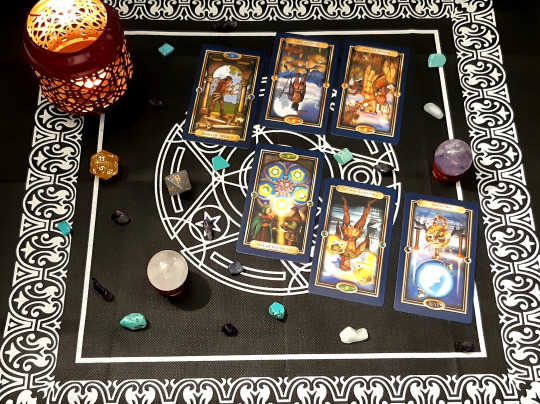
TAROTS
Mind: Seven of swords (upright)
A card about mental manipulation as “mind” is a pretty harsh introduction. But I know some players enjoy very much playing these “on the line of being a bad guy” kind of characters. Anyway, despite that first impression of lies and trickery, let’s not forget that there’s as well an undertone of adaptability and sharp wit connected to this tarot. So despite it all, Djitha is very clever in the way she deceits people. She plans, she tries to always be a step ahead of the game, which is probably how she gets away with her bad deeds.
Body: Eight of cups (reversed)
I usually relate this card to a low of self-esteem, but in Djitha’s case I feel like it’s more likely that all of the manipulating she does kind of made her forget to actually focus on her own emotions. She might be the kind of person that hides behind her lies for fear of being rejected,sure that there’s nothing interesting about her true self. So, at the end of the day we actually come back to some latent self-esteem issues in a roundabout way… For some reason I also had this very strong feeling that she would be the kind of person that strongly dislikes any kind of physical contact.
Spirit: Knight of cups (reversed)
And we even get an explanation for her “body” issues. A broken heart by another manipulator, someone that got her in a very unhealthy relationship and broke her “spirit” to the point that she decided that she wanted to become just like them so that nobody else would play her like that ever again. Full circle back to “mind”. This card also tells me that sometimes Djitha jumps to conclusions and has tantrums, so despite how smart she is and how much she plans… well, maybe she isn’t that wise after all.
Past: Five of pentacles (upright)
Not surprising that in the past of poor Djitha there’s a tarot that is very much about hardship, bad luck and breakups. It’s pretty obvious that her life was not easy in the past but her background connected to this tarot and to her tendency to lie, made me really think that she had both a hard childhood, a nasty abusive relationship in her teen years, AND some kind of scandal related to her work when she was a grown up because of her manipulations and lies.
Present: Two of pentacles (reversed)
This card just confirmed my suspicions. The poor decisions she has made in the past probably left poor Djitha in a bit of a pickle financially speaking. And for a person like her that really likes to feel like she has control of everything, even a little setback is kind of a big deal that would make her spiral even more in tantrums and uncontrollable fits of rage for the things she doesn’t know how to control. She’s probably in the “trying too hard” phase after that mess. Which would probably mean lying a lot but in a very careful way (so, not a lot of speaking, really), lots of brooding and thinking way too loud (but overall a lack of actual organisation), and maybe a short fuse on those tantrums.
Future: The Moon (reversed)
Once again, full circle and right back to the top. She will get out of that funk in the future, but it kind of seems it could go in two ways: either by deceiving even herself that everything is gonna be okay because her lies have already been discovered and she can build some new one on the ashes of those, or by actually admitting the truth and living with the consequences of her actions. Still, the major point of this tarot is that she’ll soon be dealing with mental issues. And I already pointed out how many Djitha has, of course. So, my suggestion is that whatever ends up happening while playing, this decision on which path to follow should also very much be related to how much her fears and issues are explored with the other members of the party.
FULL BACKSTORY
Djitha was pretty much rejected from birth by her family. Her parents were both humans, and despite having two older sisters, Minea and Lahrysa, she was the only member of the Elair family of infernal heritage. Her father Haluk especially blamed Djitha for the sickness that made her mother Riette die prematurely when Djitha was just three years old. Haluk somehow also found a way to blame her for their life on the street, despite that being the way they always lived, dirt poor since Djitha had memory.
Despite the hate she received from her family, Djitha was easily loved by others around her, especially because she quickly learned how to be a people-pleaser and how much she could gain if she just smiled a little bit even to those she didn’t necessarily like. It also helped to keep a semblance of peace with her father, who was pleased when she brought back food or some coin when she begged in front of shops.
When she was around fourteen, her father pretty much abandoned her because he thought she was adult enough to feign for herself. Already used to a life of begging, Djitha was convinced that she could become a thief, but she was quickly caught red handed; like always, it was her attitude of manipulating the truth and people that got her out of the situation. She convinced the chief of the city guards that she could be more useful working for them, investigating the less reputable areas and reporting back suspicious activities, since she was so well know and loved.
Because of her job and the sense of fulfillment she felt when she helped the guards to catch criminals, Djitha got involved with a man, Temithope Paquet, a bit of a celebrity of the local criminal syndicate (almost a criminal right under the nose of the guards that could not be caught because proof against him always had a way of being misplaced).
He was way older than her, but Djitha was sure that she couldn’t be fooled by him. Either because Temithope was very good at persuading people, or because she was very young and lonely, Djitha actually fell for him pretty quickly and became his pawn that would give information on the guards activities so that the syndicate could do whatever they pleased.
It only took a couple of months of abusive relationship filled with demeaning comments, before eavesdropping on one of his conversations with someone else from the syndicate made Djitha decide that enough was enough. Djitha finally saw how empty all of Temithope’s promises of easy riches and power were, and decided that she would no longer be his plaything.
Trying to seek revenge, Djitha actually convinced the chief of the city watch that she had been trying to play the long-con with Temithope and gave them a bunch of proof of all the nasty things Temithope been doing in those months. With her abuser finally behind bars (despite him promising revenge for it), she was allowed to become officially part of the investigation team.
At first Djitha thought that she would find a new purpose in her career. But she soon found out that she was still considered a nobody and that trying to do things “the right way”, by following the rules wasn’t gonna get her anything (especially nor riches neither power). Unlike breaking them, which she had somewhat positive experience with overal (she could actually order around people when she was under Temithope’s protection). So she started, once again, working with the criminals in the city.
Djitha was sure she was doing alright; people in the guards were happy with her tips on meaningless goons while she protected people in high places in the criminal hierarchy. Everything was fine, and she was starting to grow a reputation again, until, during a massive investigation with people undercover, she was finally sussed out.
Desperate to get out of town and find a way to keep being hidden, it was easy for Djitha to accept the offer her patron made her to give her the power she so desperately craved and that surely would keep her out of jail. She had things to do for her patron now, after all, it was in her patron’s interest to keep are hidden…
SUGGESTION CORNER
Suggested features
Ability scores: High Charisma and Intelligence, Low Wisdom and Strength
Skill proficiencies: Deception, Intimidation. *Instead of Insight from the Investigator Background, talk with your DM and ask if you could go for either Stealth or proficiency in thieves’ tools; I feel like it fits better with the complete story of being involved with criminals so much.
Others: I suggest either pact of the Chain or pact of the Tome. I do think this character would be a very nice multiclass wizard, but spellcasting multiclass is kind of a pain, so I get why you might want to stay away from a thing like that. I decided not to go into details on the Patron. It’s very much a matter to be discussed with the DM in my opinion, so I kept as vague as possible on that matter.
Suggested Characteristics
Trait: I think money is the true measure of appreciation and affection. Everything else is talk or an act.
Ideal: Money and power can be gained more easily with a fake smile than a real opinion. I plan to gain as much as possible.
Bond: My past mistakes cost me dearly. I’m actually, maybe, a little on the run for a crime.
Flaw: People who can’t take care of themselves get what they deserve (something she actually “learned” from that abusive relationship and VERY MUCH applies to herself most of all).
#tarots#dnd#dnd character#dnd 5e#warlock#tiefling#fiend#city watch investigator#seven of swords#eight of cups#knight of cups#five of pentacles#two of pentacles#the moon#dungeons and divination#high charisma#high intelligence#low wisdom#low strength#never not gonna say I'm sorry for the crappy quality of those photos#still italian so if my english is weird that's why#backgrounds are mainly guidelines so I hope you are okay with the slight changes#i really wanted her to give the vibe of the corrupted authority figure
1 note
·
View note
Note
sorry if this is a dumb question bt how do you decide which parts to watercolour and which parts to embroider ?
Hi! I don’t think this is a dumb question at all, this is like, a whole artistic process! It takes a lot of consideration and knowledge about how the different media will appear on the cloth to make the best decision for the art overall! Several people commented recently about how the watercolors help make the line work stand out more, and I agree completely. Too much thread, or thread stitched in different directions or with different techniques can distract or muddy up the whole thing and leave you with a less satisfying result. BUT! Too much watercolor or blank space leaves the piece looking empty! It’s a challenge!
I’m going to use a lot of examples to demonstrate what I mean. So uh, long post a-hoy:
Textile arts are awesome, and there are so many different kinds of stitches that offer a whole range of textures. I use three of those: backstitch, satin stitch, and detached chain (daisy) stitch.

[Image 1: work in progress of a Captain America work with a focus on the stitching; Image 2: Newly young Steve embroidery, with a focus on the satin stitching; Image 3: Captain America and Jarvis embroidery, with a focus on the chain stitching on Cap’s suit]
So for black line/stitch work, backstitch is for all of the outlines, satin is for filling in, and detached chain is for Captain America’s weirdo fish scales on his suit (and the R in my stitched signature 😄).
When it comes to choosing thread vs watercolors for colored (non-black) areas, I have a few generalities that I use: satin for action/block text and watercolors for most color area fills.
Block lettering looks especially cool when all of the satin stitch is in the same direction and that, in itself, helps the text jump from the cloth, just like the text jumps from the page.
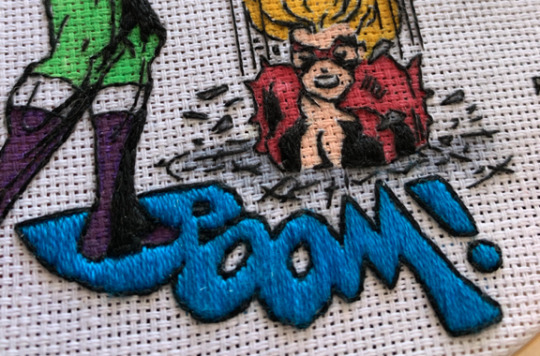

[Image 1: Close-up of the BOOM from 3-part She-Hulk embroidery; Image 2: THRUMKAPOUM text from The Tank embroidery]
Something that both of those lettering areas have in common is a lack of tiny or tightly grouped stitches. Stitches like this:
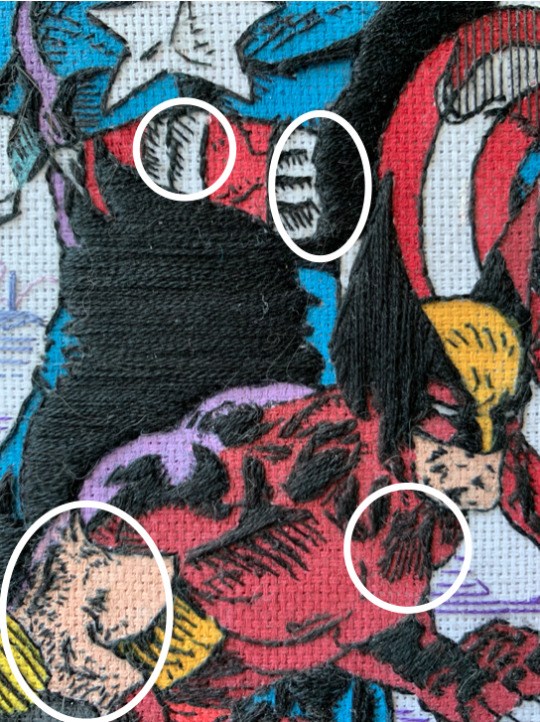
[Image: Close-up picture of Cap+Widow+Wolverine embroidery, with highly detailed areas circled with a bold white line]
These are the places I always use watercolors. Even if I could fill in those areas with colored thread, it would be almost (if not completely) impossible to also have them be in the same direction as the other satin stitch AND to keep the sharpness of the stitch itself. Just half a millimeter of difference genuinely changes the shape/slope of the stitch. Not to mention that the satin stitch will pull on the cloth, which will warp the stitches it surrounds. In summary, I don’t want to lose detail just to fill in color with thread.
There are needlepoint artists who use the chain stitch or back stitch (or others) to fill all sizes of space in their embroidery. I admire their work, and for a while I thought they were evidence that I wasn’t a good embroidery artist since I was “cheating” by using watercolors, but I know better now. There’s nothing wrong with having a style, and my style is effective and looks fucking cool, especially for comic recreation.
Watercolors are also effective for interesting and complex areas:

[Image: the Silver Surfer embroidery]
Could I have recreated that smoke effect with thread? Yeah, but it would have not really been a background then, you know? The Silver Surfer is the focus, not the background. Watercolors help keep the background as background without losing the color and shape complexity.
I am also a big fan of NOT coloring and letting the black line work be the focus:

[Image 1: Mockingbird embroidery; Image 2: Widow’s Jump embroidery; Image 3: She-Hulk embroidery; Image 4: PWANG embroidery]
I’m making all of this Thread vs Watercolors sound so clear and easy, but that’s because I’ve had a lot of practice and learning experiences. So I want to use a specific example for a work where I was really challenged with color: The TANK.

[Image: The Tank embroidery, from the 4-part Bucky Barnes work, with a small insert in the bottom left corner of the original comic panel]
Obviously in this comic panel, the tank is the focus, but I spent a really long time thinking about all of the rocks surrounding the tank as well as the rocks in the background. How do I make it obvious that there are rocks in front of the tank without distracting from the tank itself? How do I recreate the depth of the original comic between the foreground rocks, the rocks just behind the tank, and the wall in the background? Do I add any shading to the rocks like the comic has? And what about all the smoke??
For a long time, I considered using watercolors for all the rocks and background, but it never felt right, especially when I already knew I needed to watercolor the tank. So my first decision was made - no watercolors for the rocks and background. But then that kinda ruled out using just black lines for the background and rocks - there’s too much going on to just outline it without any color. I had been toying with the idea of darker floss colors for the rocks in the front and lighter in the back, but man, I was so nervous! What happened if by the time I finally stitched the background, it didn’t look like I had imagined it would? And jeez, I did NOT want to restart the whole thing if it looked bad. (This was a commission, so I couldn’t just say “OH WELL” and scratch the whole thing.) Luckily, the three brown shades for the three layers of rock was a good choice, and it turned out really rad - providing depth without distracting from the Tank. One place where I changed my mind was on the black watercolor fill behind the tank. I had been planning to stitch it, but that is definitely a place where the stitching itself would have taken away from the rest of the piece; that black section is the most background part of the whole picture - the last thing I wanted to do was bring attention to it by using thread.
There are a lot of parts of this that didn’t turn out the way I imagined at first, but they turned out for the better, not worse, and that’s because I trusted my artistic intuition and took some risks! I’m still really proud of this one.
Oh boy, I hope this has helped a bit, or at least given you a little peek into my decision-making process when I’m stitching. You are always welcome to ask more questions (maybe I’ll keep it to under 1k words next time 😅) but I think a lot of it comes down to creating and practicing and testing and deciding for yourself what you like. Really, that’s all that matters. Does it make you happy? Do you like how it looks? Then do that again. If you don’t? Try something new!
Happy stitching (and watercoloring)!
263 notes
·
View notes
Text
Final Fantasy XII: The Zodiac Age Part 2 - Balthier, Ashe and Vayne + Overall Review

I am surprised at the assassination of Emperor Gramis, and I’m not sure what to think of it. I wouldn’t discount Vayne from being capable of killing his father, since really, killing him presents more pros than cons, especially considering his old age and his alignment with peace (like Larsa) rather than war and military might (that Vayne grew up with and believes in). In addition, with the greedy Senate constantly trying to put Larsa as a puppet on the throne, Vayne needs to solidify his rule if he wants to protect Larsa and the Empire imo. Tbh, with how Vayne seems to be, I feel like he wants to do all the dirty work and then have Larsa get to live peacefully or something. On the other hand, Gabranth seems rather loyal to Gramis, since he was giving him updates on Vayne. He also seems to be aligned with Larsa, it was kinda hard to watch him have to kill the other lady Judge that was on his side to prove his fealty to Vayne though.

Who would have thought that Balthier was once upon a time a judge for a brief time? And to think that his father is the Cid guy at Draklor lab obsessed with nethicite. I think it must have been pretty disheartening to see his father like that and even have to make the choice to run away instead of staying with him. I think I can kinda understand better why Balthier chose to continue to go on this journey with everyone. He’s been running away from everything all this time, he probably thinks that it’s about time he faced it all, especially when despite all his efforts to escape from his father etc, in the end he gets roped up with Ashe and them anyway. It was nice of Balthier to tell Ashe his story hoping that she wouldn’t follow in the footsteps of his father, and be obsessed with the powers of a stone to rule Dalmasca. Cid seems pretty interesting! Not only does he have Venat (one of the Occurians, a heretic though) beside him, but I thought his plan to lead the party to Giruvegan to get the nethicite/treaty sword was smart. Well, the party don’t really have a choice either way though even if it’s a trap, since they do need the power, and only Ashe could have been chosen by the Occurians to wield it (due to her having the Dynast-King’s blood). I have to say though, Giruvegan was an annoying place lmao, I honestly didn’t remember anything much about FFXII, but I definitely remember summoning Belias to get through, and I probably got lost the first time as well, because dang were those areas a hassle to get through lol. But seriously, you can tell with how the Occuria acted with Ashe that they see humans as beneath them, and they just want to use Ashe to destroy the Empire because they’re trying to forge a future without their “guidance”. Yay, I always love guests so it’s nice to have Reddas join the party to venture to the Sun-Cryst. It’s kinda interesting how big of a decision Ashe will have to make when she gets there though. Will she choose to destroy it and all the nethicite or will she choose to break a piece off of it to make nethicite strong enough to fight against the Dawn Shard etc? It’s kinda nice but also saddening that Balthier is leaving the Strahl (his airship) to Vaan if anything were to happen to him…

I thought it was pretty cool to see how so many people around Ashe were trying to influence her decision, especially with the appearance of Gabranth revealing why Reddas decided to come here with them; it’s because he was also an ex-Judge, and he used the Midlight Shard once upon a time and destroyed Nabudis. It was because of that, he wanted Ashe to not repeat his mistake. Cid is certainly pretty out of his mind due to his research and will to experiment, it’s kinda saddening that Balthier and the others had to kill him in order to stop him. At the same time though, I feel like for Cid, he feels sane whilst insane? Haha. Is this the first time a Cid in the FF games has been evil though? How interesting~ Didn’t think the Sun-Cryst would go crazy like that though, it was disheartening to watch Reddas sacrifice his life to break it using the sword, never really realised that anyone could wield the sword to break it though, I thought it had to be Ashe lol. Either way, a difficult end, but something that one of them had to do. To think that the Sun-Cryst awakened Bahamut though! That is something to look forward to. Terrible that the impending war is now practically happening now though, and Dalmasca will be the battleground. Larsa’s heart is in the right place, but Vayne is right, if Larsa wants to show and prove that Vayne’s methods are wrong, he needs to muster the power to show him that his way is right then. Vayne is ruthless but that’s how he’s survived all this time and protected Larsa. It’s not easy when he has to put his guard up against most of the people around him. It was pretty brutal when Vayne shot that laser and destroyed a few of the Marquis’ ships, the Marquis honestly really doesn’t have much of a choice but to rely on Ashe and party to stop Vayne from inside the Bahamut tbh. I guess it’s good that Larsa is helping them out lol.

Well that last bit leading to the ending wasn’t long at all! Legit just defeat Gabranth and then killed three forms of Vayne and you’re done! Anyway, I’m not sure how I feel about the ending because it felt kind of rushed. But I guess I didn’t mind it either. I really liked how loyal Gabranth was to Larsa, so it was kinda saddening to see him die, but I think it was great to see Basch fulfill his dying wish by succeeding him as a judge and thus supporting Larsa’s rule. I think it’s really interesting how they truly are twins in the sense that even though they were on different sides, their loyalty to their liege was very similar throughout the game. Honestly though, it’s hard to think of Vayne as an “evil” person, like yes, he’s done terrible things that has caused people to die, I don’t doubt that, but I think you can really understand his motivations? He’s always been protective of Larsa, so a lot of my impressions of what Vayne did kinda felt like he set up everything that came to be through his regime of violence was so that he could give the best setting for Larsa’s idea of peaceful negotiations between countries to come to be. With the state of the Empire as it was when Gramis was alive or even when he died etc, it was obvious that Larsa didn’t have the power and influence to achieve what he wanted, but through Vayne’s actions, people were able to see the contrast between them. Also, Vayne needed to ensure that the Occuria who still think they have the right to interfere and rule over humans had no more power in doing that, in order to ensure that Larsa in the future wouldn’t have to encounter such problems. Destroying the Sun-Cryst fulfilled that and I’m happy they were able to free humanity even if their methods were questionable. I think Vayne underestimated Larsa’s strength and conviction though, but I think he’d be happy if he was wrong about that imo.
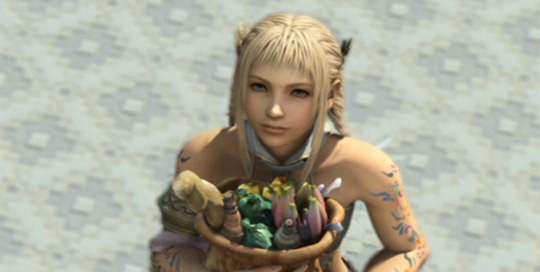
Anyway! Seeing Balthier the leading man protect Dalmasca by directing the falling Bahamut elsewhere with Fran was awesome! I knew he wouldn’t die, but I found it hilarious how later on, he just randomly took his Strahl back from Vaan and Penelo who were maintaining it hahaha. I also found Penelo’s new look really cute! Much better than her old look haha. It would be nice to see it as a costume in DFFOO! I find Ashe’s ending rather lonesome and saddening? She did everything to reclaim her throne and her people, and yet in the end, she loses the people she journeyed with to become Queen. I guess it’s normal though, and I guess like Penelo, I do hope that Basch can one day go back to be beside her. It’s nice to see that Vaan and Penelo get to be like Balthier and Fran, and travel together as sky pirates haha. I wish we actually got to see Balthier and Fran again though. Oh well.
Overall, honestly FFXII kinda renders the same feelings I did when I first played it, maybe it’s a bit more positive this time though! Like, really, I did enjoy the story but I definitely found the characters and their development lacking, mainly everyone aside from Balthier, Vayne and maybe Ashe, but then Ashe only really drives the story and doesn’t really thrive as a character so hmm. I feel like they could have added more scenes to really develop the others because I felt that I was just following along for the story, but didn’t really care for the characters. I still really liked Balthier’s personality and his background though and I find that the highlight of FFXII, especially when he interacted with Ashe and kinda told her about his past. But yeah, there were a lot of scenes I liked and I did enjoy it overall, but I’m not a fan of the gameplay either, so I kinda gave up on the side missions hahaha. I honestly took so long to finish the game because I just couldn’t get into it lol. BUT, I love how customisable the gambits are omg! It’s so crazy how much time I put into experimenting with them haha, but despite that, I found the gameplay rather tedious so I just went through the story. And yes, the story is really short imo, it felt like it would have been a great movie instead haha. Also yes, if FFVII Remake had even a tiny bit of these gambits, I think I would have cried in frustration less lmao. Anywho! Nice story, execution kinda choppy and short but still good, gameplay average, and characters just a means to an end. 7/10 imo haha.
3 notes
·
View notes
Text
Transcending an Invisible Barrier
Privilege is a concept that in some way or another has touched every single person’s life. Whether you have been on the receiving end or had to experience the struggle for equality, privilege has impacted everyone, and it would be ignorant to ignore its ramifications. What exactly is “privilege”? Definitions vary, but I think of it as a guaranteed head start on life based on advantages that have not been earned through personal action. This advantage can be embodied in one’s access to education, culture, ethnicity, gender, wealth, and so much more. The common theme linking these topics is the glaringly obvious lack of control an individual has on them.
It would be naïve in saying that I have not grown in a very privileged household. My father grew up just south of Denbigh, ON with unlimited access to thousands of kilometres of Crown land right in his own backyard. When it comes to early exposure to nature, you could argue that he had an advantage over other people. He passed this privilege onto me once I entered the picture. When I was young, we spent countless nights camping on spots only accessible by ATV and boat. Then as time went on, my family invested in 2 properties in the same area he grew up. I did not really understand how lucky I was to grow up in a family that had the means to provide not only opportunities to spend time outdoors but to properties that make access easier. As a kid, it was something I thought everyone had an opportunity to do, but as I became more aware, I realized that this was a privilege, not a guarantee. Growing up with opportunities to spend time in a diversity of environments allowed me to pack my “invisible knapsack” (McIntosh, 1989) with assets not all people are able to readily earn. I grew up with a healthy respect of water but not fear, as I mainly learned to swim in lakes. I never had to worry about not having the right gear when we went camping or hiking. Having the right gear made me more comfortable exploring forests, therefore I was more curious.

(Barker Lake at our family camp. Photo taken by my father)
Understanding the role that privilege plays in society and everyday interactions is an important skill to have in nature interpretation. Each visitor has their own “invisible knapsack” (McIntosh, 1989), filled with both advantages and disadvantages that influence how they view the world and their position in it. Therefore, as an interpreter, you cannot make assumptions about visitors and what will best target their interest. Different factors may change another individual’s relationship with nature, and consequently how they digest your interpretation. What a visitor considers beautiful, risky, or irrelevant changes based on their own experiences. My own knapsack left me free of fear of nature and more interested in pursuing further education. In order to target an audience effectively, you must consider the privileges that may separate you. Not every person shares the same background knowledge and what I might consider “common sense” could be completely new to someone else. As Beck and Cable (2011) say, “Instead of looking upon people with reproach, our role is to assist them, to guide them without condescension.” It is the job of the interpreter to make everyone feel welcomed and accepted when learning about nature, no matter what they may carry in their own knapsack.
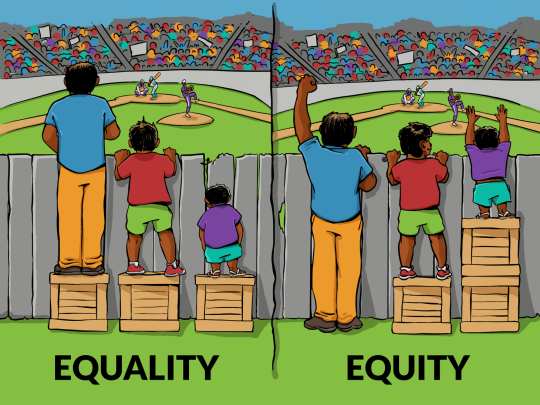
(Interaction Institute for Social Change | Artist: Angus Maguire. Learn more at interactioninstitute.org and madewithangus.com)
References:
McIntosh, P. (1989, July/August). White privilege: Unpacking the invisible knapsack. Peace and Freedom, 10-12.
Beck, L., & Cable, T. T. (2011). The Gifts of Interpretation: Fifteen Guiding Principles for Interpreting Nature and Culture. Urbana, IL: Sagamore Publishing.
14 notes
·
View notes
Note
In your opinion, is murdering children/using them as hostage leverage in character for Two face? I've been wrestling with this question for a while, and I'm of two minds about it (ha punny). I know he's attempted to kill kids in batman media before, with seemingly no remorse, but I'm wondering whether that's fully in line with his idea of justice or not? Any thoughts you have would be much appreciated
It took me three or four times to read through this to understand what you meant, but I’m assuming you mean Two-Face holding the child hostage/murdering them, and not someone holding a child hostage against(?) him.
Yeah he has hurt kids in the past in media (the one that comes to mind most is The New Adventures). Generally speaking the only kids I’ve seen him hurt are variations of Robin and other vigilante kids. Same with hostages (again, TNA with Tim Drake coming to mind).
In my opinion, no, it doesn’t fall in line with most of his sense of justice. I think there is a lot in him that recoils with regards to interacting with children, for obvious reasons. This includes both negative and positive interactions, in my mind. I think that someone who has not only been abused so severely as a child, but someone whose behavior and morality has been so affected by this abuse--someone who is also hyper-aware of how much he has been affected by his background--would be wary in handling anything to do with children. Not just for their sake but his own stability, because reminding yourself of your own traumatic history through your perpetuation of actions is the last thing you would want to experience.
However, any area of unease and lack of security generally falls to the coin. I think that generally, his first resort is just not to bring kids into the situation, out of avoidance. He isn’t really the type to hunt down innocent victims to begin with, so coming across random kids seems a stretch in many situations--again, especially if he is avoiding situations where he would even encounter them. With situations of Robins and other Batfam, it’s a case of having to confront very competent kids that are making his life hell. And so, the coin as to how to deal with them.
His justice is two-sided, and the Two-Face/Big Bad side is still a version of justice. Not an ethical one, but still firm in that it is based in retaliation and retribution. It is reactive, deceptively emotional in spite of its ruthlessness, and authoritarian where the other side is more pragmatic and strives to stay detached as a mediator of situations. Because of this, the bad side of the coin very much fits the profile of lashing out at vigilante kids that are in his way. They are a threat like Batman, and will be treated as such if the coin decides it.
This isn’t to say that Two-Face wouldn’t lash out at innocents, but his view of who is an innocent has become way narrower, more stringent. Hence why many adult bystanders may get caught up in his fury, because they are “complicit” in whatever injustice he is fixated on. Children, with the exception of pesky Batfam that are just plain infuriating, not so much.
54 notes
·
View notes
Text
Not my president? - Understanding charisma.
Note: While I’m reworking this blog’s format, I wanted first to finish a planned series of posts on charisma that I began publishing a while back. Rather than making it a series, I figured I might well play around with a long-form format instead. This post will re-hash some of the information from the earlier post, but this time I promise it will actually reach a conclusion!

With US election campaigns in full swing, and with Democrats hoping to oust Trump from the Oval Office, the question of how Trump won at all has re-emerged. After four chaotic years, no-one Blue would want another four. Despite a laundry list of failures, scandals, and broken promises, will Trump be able to galvanise enough voters – again? Though I am by no means an expert on US politics, I feel that one area that a lot of pundits and commentators have failed to consider is that of his charisma. At the end of the day, it is Trump’s charismatic leadership that allowed him to be elected in the first place - and bear with me on this! We must really begin to look and deconstruct charisma to get to the heart of it all. Make no mistake, charisma serves a fundamentally important function within any democratic system – they would not be able to operate without it. As oxymoronic as it might sound, charismatic leadership is not reserved for the despotic, but it is a process we all engage with.
Who are our charismatic leaders? We think of Gaddafi, Stalin, the Kims in North Korea, or indeed the Ayatollahs in Iran – alongside questionable undercurrents of fooling the masses, abusing one’s power, and the creeping, assured emergence of ever more oppression. Charisma’s negative political baggage, however, doesn’t really help us to understand what it functionally is. So let’s shed all judgement, positive or negative, and instead look at charisma as a process. German sociologist Max Weber succinctly defined charisma as
“a certain quality of an individual person by virtue of which he is set apart from ordinary men”
In other words, charisma is a sort-of otherworldly quality that sets you apart from the masses. Authority is derived from charismatic qualities. Unlike other forms of authority, such as legal-rational authority (which relies on some sort of legal code, such as, a constitution) or traditional power (where authority is derived from something outside of the system itself, like the divine right to rule), charismatic authority comes from the very simple fact that people want to follow you.
It’s quite evident that Weber effectively sees charisma as some innate and mystical power – some sort of magic you have that makes people want to follow you. So, let’s look at Weber’s definition from a different perspective. Let’s consider charisma as something you do, rather than something you have. Charisma must always be the result of a set of rhetorical actions intended to convince the ‘common man’ that the charismatic person is indeed not common. Through such conviction, the ‘common man’ becomes a willing follower. In his book How to do things with words, J. L. Austin outlines that there are two different kinds of rhetorical actions: referential and performative. Referential actions simply describe the world, which means that it is either right or wrong. Performative actions, on the other hand, doesn’t describe anything at all and therefore cannot be right or wrong, merely successful or unsuccessful. To shamelessly steal an example from Alexei Yurchuk:
“If one makes an oath under appropriate conditions, while internally not intending to keep it, the oath is not made any less powerful in the eyes of those who accept it as such”.
Assuming you accept the above, charisma as something performed has some broad implications in the real world. But to make sense of that, we need to look at the typical Western democratic system.
Democracy comes with an awkward promise: that all people are created equal, and that the whole system is run by the people and for the people, while at the same time requiring elected hierarchies and leaders to effectively function. In other words, democracy only works because we’re willingly giving up our sovereignty to the system – something which, in most situations, might be perceived as deeply undemocratic. This tension, obviously, needs to be resolved somehow. The relationship between the State and the leader is roughly analogous with the relationship between power and authority. The State has power, and without diving far too deep into Foucault, power is inherently relational rather than what we might classify as material. Put simply, it emerges from social structures. In the case of the State, this relational power is very clear when you consider the different experiences and interactions different people – minorities, the homeless, immigrants, the privileged, and so on – have with its representatives. They all have a very different relationship to the State as an entity (anthropologists Veena Das and Deborah Poole refer to this as the ‘centre and the peripheries’, arguing that the best place to ‘see’ the State is the border at which its power breaks down).
In the same way, the State as an entity is also immaterial – we only interact with representatives of the State (civil servants, politicians, police officers) or we see the outcome of these representatives enforcing the power of the State upon us (laws, regulation, taxes). Authority, on the other hand, is effectively the ability to ‘direct’ power. The leader of the State relates in the same way to its structure, coming to embody the system as a whole, while the structure itself maintains the overarching power relations.
It is commonly understood that states only ‘work’ as a concept if the people within them act as if they do, something akin to the thought experiment of ‘would war end if all soldiers refused to fight?’. The leader, as the embodiment of the whole structure, begins to play a key role in maintaining this illusion. Much work has been done on this idea of ‘two bodies’. Alexei Yurchuk wrote that this set-up is traditionally very common among kings and other monarchs – in some cases very literally, with dolls being made of the monarch upon their deaths to quite literally give them a second body. The bodies a king inhabited were their ‘individual’ body, i.e. the person itself, and the second being that of the ‘office’ of Kingship, a divine-like body. It is this second regal body, in full regalia upon their throne, surrounded by servants and gold and pomp and circumstance, who is truly the king; the individual person will always simply be the person. This process is largely the same within the modern democratic state: there is the elected individual – the person – then there is the leader (president, prime minister, etc.), the embodiment of authority.
It is here we must return to what I wrote above about voluntarily submitting. When imagined, the idea of a leader as an embodiment of authority immediately sounds inherently un-democratic; non-democratic at best. It is this tension, alluded to previously, that charisma serves to reconcile.
It may sound contradictory, but in these cases charisma functions to dictate how – for example – a President can behave. It is what causes world leaders to attend particular events, or why they partake in completely-natural-totally-not-staged photo-ops. It’s not necessarily because they want to, or indeed because they think it’s fooling anyone, but rather because it is what the system requires the leader to do. It is, in other words, charismatic performance. Even more importantly, it is not the individual which fulfils the requirement, but rather them in the function as President. It is their second body, so to speak, which is having their photos taken beside some national memorial. This leads us to the crux of the whole situation: returning to the issue of democracy and leadership. We the people need to willingly submit ourselves to the leader’s authority. This is often done through voting. However, to effectively convince people, the leader must not only follow a particular agenda, philosophy, or give the correct promises, but they must also follow along in the ‘dance’. They must act statesmanlike (stateswomanlike?), to fulfil what we can in practical terms call ‘the minimum amount’ of charisma needed to be considered for leadership at all. In this sense, all democratic leaders are (somewhat) charismatic, by necessity.
Nonetheless, this of course highlights that charisma isn’t binary, despite often being spoken of in terms of haves and have-nots. Instead, we should imagine charisma as a spectrum: two people can be charismatic, and one more so than the other. Indeed, it also means that charisma is individually understood, that is to say, that different people are differently charismatic to different people. Despite the initial Weberian definition, it isn’t a magic spell. It is a performance, a dance, which functions as a safety-vale in Western political systems, a means to reconcile what is seemingly a fundamental contradiction.
This, of course, has very real-world implications. Let’s turn to an example. A rather thinly veiled metaphor, if you will, but such a reduction of an (obvious) example can help give some grounding – while playing with some nuance. You have Mr Red and Ms Blue, two presidential candidates in a totally hypothetical country. Ms Blue is a well-established politician, with a strong pedigree of various political posts. She’s experienced, educated, well-spoken, intelligent, and internationally respected. Mr Red, a newcomer on the stage, has no background in politics. He is radically outspoken, blunt even, criticised for his lack of experience, his limited rhetoric. His background is as a somewhat successful businessman, a stereotype he fully embraces. He’s divisive, to say the least. I’m sure you’re seeing where I’m going with this.
Within this completely hypothetical country, you have a traditionally large working class, which used to be strong in the past but has since declined as production jobs moved overseas. The perception among this group is that they have been abandoned by the powers that be – abandoned for several generations. They feel they’ve been systematically shut out of politics, unable to make themselves heard (lack of education, money, and so on), while the politicians – across the board – have continued toeing the same line. The established body politic, like Ms Blue, doesn’t much represent, let alone understand, them. Stage right: Enter Mr Red, down a gilded escalator. His rhetoric is outrageous, his promises ridiculous, his beliefs morally bankrupt. No-one believes what he says, not really. But it doesn’t matter. Mr Red wins anyway. He wins every time. Why? Because he dances to the tune of these otherwise marginalised voters. He speaks to them, makes promises for them, and whether he intends to keep these promises or not, or indeed whether he is expected to keep them, is irrelevant. At this stage, it was no longer about his promises but rather because he acted to this otherwise downtrodden group as the State, the leader, is expected to act: he listened to their issues, spoke to them directly, in a language they could connect with, made them a part of his wider political discourse, stepped out of the ivory tower, extended his hand as a candidate for the Presidency. He at this stage fulfilled the minimum amount of necessary charisma to even be considered as someone to follow. To counterweight this, Ms Blue maintained her distance and stance, equating herself with previous ‘establishment’ politicians, and as a result became unelectable: not because of having a worse programme, or lack of political merit, but rather because she became someone impossible for these voters to follow at all. She could not have been voted for, because she didn’t dance at all.
Charisma, though a funny thing, something we’ve all heard of and often instinctively see and understand, operates in not only a perhaps more complex way when dissected, but also with much more material force. In a sense, society as we know it requires a particular ebb and flow of charisma. But even then, it is not as random or magical as often believed; instead, it is simply the result of certain actions, of convincing people that you are indeed charismatic. Weber throughout most of his career maintained that charisma cannot be learned, that it was something you were born with, though he might have changed his mind on this, as an unfinished paper (sadly only a collection of notes) showed that he intended to write a paper on learning charisma after all. This isn’t the topic here, though, but rather to understand charisma as a social performance, a dance, which lies at the heart of the Western political system and discourse. It is a force rarely considered, not often analysed, and if even invoked, done more so to paint a mystical picture of the person in question.
The funny thing, of course, is that all leaders are charismatic, and necessarily so. Some do it better than others, of course, but without it democracy as we know it wouldn’t be able to function. Without charisma, we would all simply vote for ourselves.
Selected bibliography / recommended reading:
Austin, J. L. 1955. How to do things with Words (J. O. Urmson & M. Sbisàeds ). Oxford University Press.
Das, V. & Poole, D. (eds.) 2004 'Anthropology in the Margins of the State' Santa Fe: Scool of American Research Press; Oxford: James Currey Ltd.
Hansen, T. & Stepputat, F. 2006 'Sovereignty revisited' Annual Review of Anthropology, vol. 35
Weber, M. 1946 [1919] 'Politics as a vocation'. In Gerth, H.H. and Wright Mills, C. (trans. & eds.) Max Weber: Essays in Sociology pp. 77-128. New York: Oxford University Press
Yurchak, A. 2003 ‘The Soviet hegemony of form’ in ‘Everything was forever, until it was no more’ Comparative Studies in Society and History 45(3): 480-510
Yurchak, A. 2015 'Bodies of Lenin' in Representations vol. 2(2015) pp.116-157 215
#anthropology#charisma#leadership#essay#ethnography#argument#politics#weber#election#the state#government#performance#social and cultural anthropology#SocAnth#sociocultural#sociology
2 notes
·
View notes
Link
via Politics – FiveThirtyEight
Suneel Gupta had his bags packed, ready to go to Washington. It was the night of Nov. 8, 2016, and Gupta, then a tech entrepreneur, was itching to leave the Bay Area and begin a new job in the Clinton White House.
“I got asked to lead up Hillary’s Office of Science and Technology Policy for the transition,” he told me. “Literally election night, I’m watching the results come in. Watching them with my wife, who is nine months pregnant with our second daughter. The next morning, I’m supposed to be on a plane, ready to go … get my marching orders.”
He calls it the shortest job of his life.
Gupta is a computer programmer who has worked as head of product development for Groupon and Mozilla and founded an app-based preventive health care company with his older brother, the neurosurgeon and medical reporter Sanjay Gupta. The Clinton job was supposed to be the next step in his career. But instead of flying out, Gupta spent the next morning unpacking and figuring out what he should do next. Today, he’s running for Congress in Michigan’s 11th District, where he grew up and now lives — one of five Democrats vying for the opportunity to flip a seat that has been solidly Republican for the past 53 years.1
When Gupta tells this story, he presents his run as the logical next step. The Clinton transition job disintegrates in front of his eyes on TV … and yada yada yada … he’s a candidate for Congress.
It’s possible it would have felt that natural, that obvious, to him after any election year. But 2016 wasn’t just any election year for scientists. Between Gupta’s personal Point A and Point B, there’s been a whole atlas of cultural movement among scientists, technologists, engineers, and mathematicians, drawing them out of labs and startups and into politics. Thousands of STEM workers and their supporters marched on Washington to protest funding cuts and what they saw as a lack of respect for scientific expertise. Some scientists took it further, forming a political action committee to train and raise money for “science candidates” — a broad category that includes people with experience in research science, science education, engineering and technology jobs. That pro-science PAC, 314 Action, counted more than 300 people with STEM backgrounds who ran or are running for public office at all levels of government — 66 for federal-level and gubernatorial seats. Gupta is one of those 66.
Science has never truly been separate from the political system that funds it and uses the tools it creates. But scientists have not traditionally pushed so hard to make that relationship explicit, or to be the ones in charge of it. In the past, said Shaughnessy Naughton, the former chemist who founded 314 Action, scientists have sort of believed that they could just put the facts out there and the evidence would speak for itself. Before this, it had been rare for scientists to get involved in politics. “But it’s clear now that politicians are unashamed to meddle in science. And the way to push back is getting scientists elected. We have to have a place at the table,” she said.
When Gupta tries to win the Aug. 7 Democratic primary in the Michigan 11th, he won’t be just a lone guy with a science background running for Congress — a single data point, if you will. Instead, he’s part of a much larger sample — dozens of people trying to grant science some political power. It’s not clear that a commitment to STEM will help him win, though, nor is it clear what happens if Gupta and other science candidates do make it into office. That could mean more evidence-based policy — or more well-intentioned newbie politicians absorbed into the same old political machine. It could mean newfound respect (and research dollars) for science. Or it could turn “science” into a dog-whistle word for “liberal.”
Nobody knows what the result will be. There’s a word for what Gupta is running in this election, and it’s not “campaign.” It’s “experiment.”
“Who are we as Democrats?” asks Lisa Dirato, a liberal activist and a research chemist. At her kitchen table, in a neighborhood of manicured lawns, gabled porticos and brick facades near Northville, Michigan, Dirato hashed out for me how she was going to make her decision for the primary. Usually, she said, Democrats are lucky to get one person to run, let alone a crowd. It was a rare experience to choose, rather than accept. And she had some specific qualities she wanted to see in her choice. “[Democrats] have empathy, we care about people and we believe government can make people’s lives better,” she said. “When I listen to candidates, that’s what I’m listening for.”
“Are you listening for science at all?” I asked her.
“Um. You know, not really. And I’m a scientist. That’s my day job,” Dirato said. “I can’t even tell you why.”
This is the first challenge that Gupta, and any science candidate, faces.
Whenever I spoke with voters in Michigan’s 11th District, they were all more concerned with the state of the roads we had driven on that day than with the technological decision-making behind that infrastructure.
Voters — whether in the Michigan 11th or the U.S. at large — don’t seem to view science advocacy as a primary factor in their vote choice. But it’s not for lack of respect for the sciences. For the past 40 years, while partisan divides have increased, the General Social Survey, conducted by the research organization NORC at the University of Chicago, shows that trust in science remained about the same and that the scientific community is the second-most trusted institution in the country, after the military. And you’d expect even more excitement for science candidates in the Democratic Party, whose voters, Pew Research data suggests, are a little more trusting of scientists and a lot more supportive of federal funding for scientific research.
In practice, though, the science candidates’ results have been mixed. Of the 23 federal-level candidates originally endorsed by 314 Action, nine have made it past their primaries (one ran unopposed), nine lost, and five primaries (including Gupta’s) are still to come. Results for unendorsed science candidates have also been muddled. And in an ongoing Gallup poll that asks about the most important issues facing American society, few of the issues identified are particularly science related. It’s pretty clear that science isn’t going to be a single-issue vote for the left as, say, abortion is for some conservatives.
Nevertheless, Gupta thinks there’s a good case for why voters should want more people with science backgrounds walking the halls of Congress. While driving between apartment complexes, delivering Meals on Wheels to housebound residents of Waterford, Michigan, he talked to me about the way Congress is called to make decisions and explore alternatives to problems — choices that often involve some level of technology. “To understand these alternatives and how they best serve the American people, you have to know what is happening underneath the covers and be able to ask the right questions,” Gupta said. “When you don’t have a Congress that’s informed, what ends up happening is that it follows the directions, very much, of the special interests.”
But whenever I spoke with voters in Michigan’s 11th District — whether they leaned Democrat or Republican — they were all more concerned with the state of the roads we had driven on that day than with the technological decision-making behind that infrastructure. That lack of interest in Gupta’s tech expertise might make it hard for him to win the primary — without it, there’s not much to make him stand out from the pack. “I don’t think he’s found a breakthrough issue yet that separates him enough from the other candidates,” said Bill Joyner, a former county commissioner who served in part of the 11th District and remains involved in Democratic politics in the area. Most Democrats I spoke to told me they were still undecided in mid-July. Recent polling commissioned by the Detroit Free Press placed Gupta in third, 7 percentage points behind the front-runner, state Rep. Tim Greimel.
But if he can win the primary, Gupta has figured out a way he might be able to make his science background work for him in the general election — not by appealing to science, but by tapping into a growing interest in outsider politicians.
Student science, technology, engineering and math clubs are friendly ground for Gupta, who has been visiting groups throughout the district for months. He’s after the young members’ votes, of course. But he’s also there in the hopes of inspiring the next generation of science candidates — during a visit to the Oakland Community College STEMulated Club in Auburn Hills, Gupta asked club members about whether they might run for office someday.
“I’m not a politician,” said Jaquan Brown, a computer science student who is spending his summer working on a project modeling wind patterns.
“Hey, neither am I!” Gupta replied.
That’s a message Gupta took everywhere — from that left-leaning college STEM club to an eagle-festooned room full of stone-faced retirees. “I’m not a politician, I’m a problem-solver.” To Gupta, science can bridge the gap between the left and the right — but so can dissatisfaction with political insiders. And while science doesn’t seem to be shifting elections, a general dislike for experienced politicians does.
What’s important in voters’ minds is that politicians haven’t held elected office before.
Incumbency is still the primary factor that determines whether a candidate will win an election, said Sarah Treul, a professor of political science at the University of North Carolina at Chapel Hill. But when there is no incumbent running — as is the case in the 11th — Treul’s research shows that it’s increasingly likely that the person with the least experience holding public office will walk away with the prize. These winners are seldom total political novices. They’ve worked on campaigns or they had been activists, or even just big donors, in the past. That’s true for Gupta (a former White House intern under Bill Clinton and a volunteer for the Obama campaign), as well as several other Democratic and Republican candidates for the 11th District seat.
But what’s important in voters’ minds is that politicians haven’t held elected office before, Treul said. These kinds of candidates always did better with Republican voters than Democratic voters, but Treul’s data shows that, since about 2008, the percentage of primaries won by inexperienced candidates has increased substantially for Republicans. “Republicans have clearly capitalized on that, going all the way to the president,” she said. “Politician is a dirty word.”
The filthiness of professional politicians came up in many conversations that I had with voters in the 11th District, and both Democratic and Republican activists in the district told me they expected an outsider to win the general election. The last two people to hold this congressional seat were first elected to Congress as novices. So it makes sense that Gupta’s stump speech highlights his outsider status in multiple ways. He’s not a politician — he’s a problem-solver who knows how to use technology to create practical solutions for tough problems. He’s not a politician — he’s a job creator who ran a successful startup firm. He’s not a politician — the only PAC he’s accepted money from is 314 Action.
That could help him in a general election in a Republican-leaning district. Gupta told me he thinks it could help him even in the primary, though that’s less clear. Democrats don’t have as strong of an attraction towards inexperienced candidates — take Greimel’s lead in the primary as an example. But to Gupta, the real fight in American politics isn’t between Democrats and Republicans, it’s between average voters and the powerful special interests that professional politicians represent. In his vision, science and evidence are a thing the warring parties can agree on, and then use to fight the real enemy.
There are real-world examples of science being exactly the kind of cross-party bridge builder that Gupta wants it to be. On July 23, U.S. Rep. Carlos Curbelo of Florida introduced a bill to create a market-driven carbon tax as a solution to climate change. Curbelo is a Republican, and he’s a member of the bipartisan Climate Solutions Caucus — 86 representatives, evenly split among Republicans and Democrats, all dedicated to advancing climate legislation.
If Gupta and the organizers of the March for Science were granted one wish from a bipartisan fairy, climate legislation championed by lawmakers on both sides of the aisle would be it. But all the results of the politicization of science haven’t exactly been the stuff of scientific fantasy.
Science can polarize people, as well as bring them together. The 2017 March for Science exacerbated — rather than healed — partisan divides, according to a survey published in the journal Political Science and Politics by Matthew Motta, a postdoctoral fellow in the science of science communication at the University of Pennsylvania. “In the aftermath, conservatives became more negative towards scientists and the science community, and so did moderates. But liberals became more positive,” Motta told me. Conservatives were more likely to believe scientists were out for personal gain after the march; liberals, less likely.
While there is evidence that science can be a unifying force that all Americans trust, there’s also evidence that — particularly on specific issues — Americans increasingly have polarized ideas about who “science” serves and what “evidence-based” means. For instance, while the General Social Survey shows that overall public trust in science has held fairly constant since 1974, it also shows conservatives losing that trust. While conservatives once had the most trust in science, relative to liberals and moderates, they now have the least. Meanwhile, congressional voting records on environmental issues became significantly more polarized after 1990, with Republicans increasingly likely to vote against anything tainted green. And there is evidence of strong ties between science and the political left. Fifty-two percent of scientists self-report as liberal, for instance, while just 9 percent call themselves conservative. (Those numbers are even less balanced in some social sciences, like psychology.) And most political donations from scientists go to Democrats.
Science is a uniter. Science is a divider. Science is a political Schrödinger’s cat.
Matthew Wilk, a Republican activist from the Michigan 11th, told me that evidence and data do matter to the decision-making process among conservative lawmakers. He’d seen that when he was a member of the Northville School Board. He and other conservative lawmakers were hungry for data, he told me. But they didn’t necessarily want academics to interpret that data. They’d rather just get raw numbers and draw their own conclusions because they didn’t trust academia to play fair. “It’s seen as biased towards Democrats,” Wilk said.
The movement to get scientist-politicians on the ballot probably hasn’t helped that perception. The 314 Action PAC endorsed candidates for all levels of public office — from state legislatures on up — and every person they chose was a Democrat. “I wouldn’t say it’s an indictment of science that scientists are running more as Democrats,” Naughton said. “It’s an indictment of Republican Party platform. It’s a real shame.”
But it’s incorrect to think of Democrats as “good” on science and Republicans as “bad” on it, Motta said. Surveys show that, by and large, liberals are more supportive of scientific research funding. “But in many ways, liberals and conservatives don’t look all that different,” he said. “They just differ in which types of scientific conclusions they don’t accept.”
There’s knowing that science isn’t a partisan issue intellectually, though, and then there’s feeling it. Politics is more about the gut than the brain. Today, on both sides of the aisle, tummies are rumbling.
“Ironically, we’re in this mess because we allowed science to be politicized,” said Caroline Weinberg, one of the founders of the March for Science. “It’s a problem if what we’re doing to resist that is furthering politicization instead of reducing it.”
This is where Gupta’s attempt to intertwine politics and science becomes an experiment as much as a campaign. Gupta talks about the importance of sharing evidence and learning. But twice on the campaign trail, Democratic supporters brought up fears about genetically modified food that aren’t supported by scientific evidence. And Gupta didn’t correct them. Instead, he pivoted to related issues of food security and safety that were less controversial. Politics might not be the best place to use science to change things people know with their guts.
What you’re left with is a bunch of facts that don’t quite add up to an evidence-based path to political success. The American people really do trust scientific expertise. But having scientific expertise doesn’t seem to be a major factor in how they vote. Americans across the political spectrum still agree on science more than we disagree. But the same surveys show that partisan divides on science exist, and every time someone runs a political campaign using science as an issue, it could be contributing to a growing divide — making it harder for science to function as a nonpartisan problem-solver in the future. Science is a uniter. Science is a divider. Science is a political Schrödinger’s cat.
For now, all Gupta can do is hope the beast is alive and well when the box opens. Which, for him, means continuing to push on the idea that he’s not a politician. He’s something else, and he can bridge divides. It’s an appealing message, said Maggie Peyton, a retiree to whom Gupta delivered a Meals on Wheels lunch one afternoon. “You’re almost talking my platform,” she told him. Though she and Gupta disagreed on abortion rights, Peyton encouraged him in his drive to get special interests out of Washington and fight career politicians. She’s one of those voters who Gupta told me he sees as a Republican with an open mind. And as he walked away from her door, pushing a cart loaded with lunch trays, Peyton waved and hollered after him.
“Don’t let politics wreck you!” she said.
7 notes
·
View notes
Text
Week 10 - Film Narrative
Critical Reflection
I find the feedback sessions on this course to be truly cathartic experiences. I am very happy with the outcome of our crit and am very proud of my group.
While I have been reflecting on the development of our project and my contributions after each week, I will quickly recap before covering the actual feedback.
In the first couple weeks, each of us came up with ideas and scripts before we voted on one. I am still disappointed about my script not being picked up by the group and really hope I am not deluded in my belief in the script. I reread it before writing this and I still love it and hope to film it some day soon.
We settled on Sam’s idea which John then developed a script for based on Sam’s treatment and beat sheet. We went through 4 drafts with everyone else in the group giving feedback after each draft. My feedback was consistent throughout the drafts - I felt that the dialogue was forced and unnatural and I didn’t quite buy into the relationship between the two main characters. For the most part, these concerns were addressed by the final draft.
Then, when we went into pre-production, I became the cinematographer. My contributions involved the shot list (which I worked on with Sam), the lighting plan, the storyboard and the animatic (which again I worked on with Sam).
The shot list was a great experience. Sam and I worked well together, talking through all possible angles and how we wanted the film to look. We thought both about on set efficiency and artistic creativity. Sam had a clear idea about the visuals but was always open to new ideas and I was able to bring a few to the table.
The lighting plan was motivated by a desire for naturalistic lighting that mimicked the overhead lighting of an apartment building. I also tried to create depth by contrasting warm, golden light in the elevator and at the reception desk with the colder white light of the overheads. The lighting is mainly inspired by the opening of Pulp Fiction (1994) and other individual shots from a wide variety of films. I use Shotdeck a lot when coming up with the visual style. I look for how other filmmakers have shot similar settings and situations.
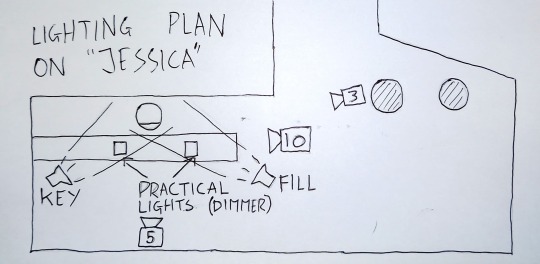
The storyboard lacks an in-depth use of colour, however, it shows my ideas pretty accurately. After having a useful chat with Sam about the shot list, I was given a lot of freedom on this. The framing is deliberately natural with some more creative touches thrown in to create more emotional specificity. The early long dolly shot allows us to get a feel of the characters and how they interact and emphasise the momentum of their back and forth. Then I used some POV shots on long lenses to show the ridiculousness of Guy’s obvious hiding and Jessica’s reaction to it.
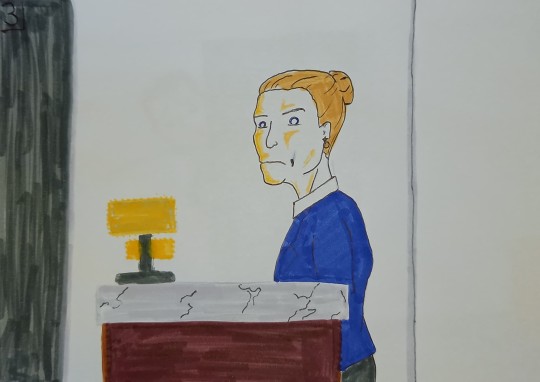

In the main argument at the pillar I placed first Jessica and then the exit in the background of the action. This was an idea I’d spoken about early in my blog - putting what the characters are thinking/talking about in the background/foreground to emphasise their inner thoughts.
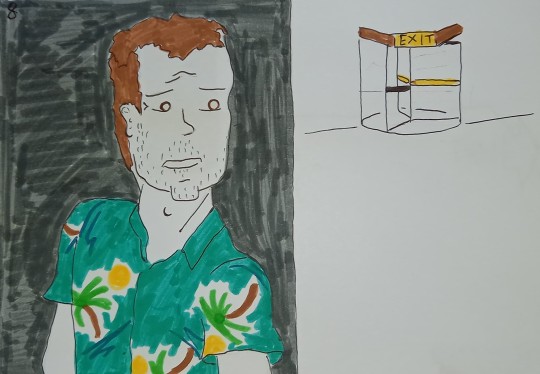
The wide OTS is to show the contrast between how Aaron and Guy behave and how they look to Jessica. Guy and Jessica’s conversation is in a 2-shot to emphasise the relationship between the two. The close-up on Aaron with the rack focus onto Guy in the background mimics Aaron’s realisation of the situation. And finally the handheld shot shows Aaron losing his patience with his friend, emphasising the hectic movement before settling on the perplexed receptionist left alone in the silence. This further shows the absurdity of the situation and makes us think about how Jessica sees what happened.
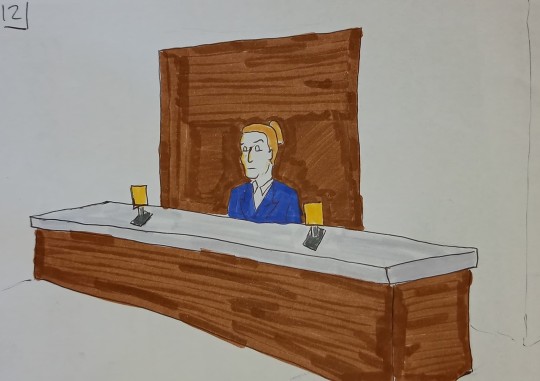
I must say, there wasn’t a whole lot of influence from other films aside from the general use of film language. Most of the inspiration came from Sam’s influences on the tone of the film - I Love You, Man (2009) and Seinfield (1989 - 1998). Again I used Shotdeck a lot to see how the lenses and frames would look in practice.

The animatic was created by Sam and I, with Sam doing the sound and me editing the image to it. We had a call where we recorded a read-through of the script with Sam directing himself and John. I think the performances are a little awkward but of course, Sam and John are not actors so they did a great job considering. Sam’s sound editing builds a believable world and hints to the possibilities for the final film. I edited the image to the sound, trying to catch the fast-paced back and forth that Sam envisioned and I am very happy with the final result.
Throughout the project, Sam, our director, was very positive with my work with little to no notes throughout. He was clear in communicating his vision so I didn’t find it too hard to carry out my tasks.
With the post-production exercises, again we all created our own picture edits before John took the lead with the submission. I was happy with my cut and would be interested to see what Kieran would’ve thought. We had one session with John where we all gave notes. John stuck to his decisions but did eventually re-cut the footage based on Alex’s feedback from the tutorial. We weren’t able to give notes on the sound edit, again completed by John, as it was a little close to the deadline. John’s final cut I think is great, telling the story clearly and effectively. Aside from some nit-picks (like the use of the heart monitor sound) I am very impressed.
Now, to the crit. The shot list was well received with the only criticism being the language/shorthand used which was Sam’s area as he wrote it out (not to throw him under the bus). With a criticism like that, I do understand it, it makes it clear to everyone involved what the plan is, however, I do think most everyone would easily be able to work out what “clean S” stands for. The only other criticism on my work was that the numbers on the storyboard frames were inconsistent with other documents in our submission. I should have paid more attention to everyone else's submissions and made sure I was fitting in to the overall image being created. It was great to hear the positive response to the storyboard, lighting plan and animatic however, I would like some more in-depth feedback as we were a little short for time on the call.
I am really happy with how the group worked together despite some creative disagreements. I’ve learned a lot about pre-production and have a better idea of what can be done and how it can help better the film.
0 notes